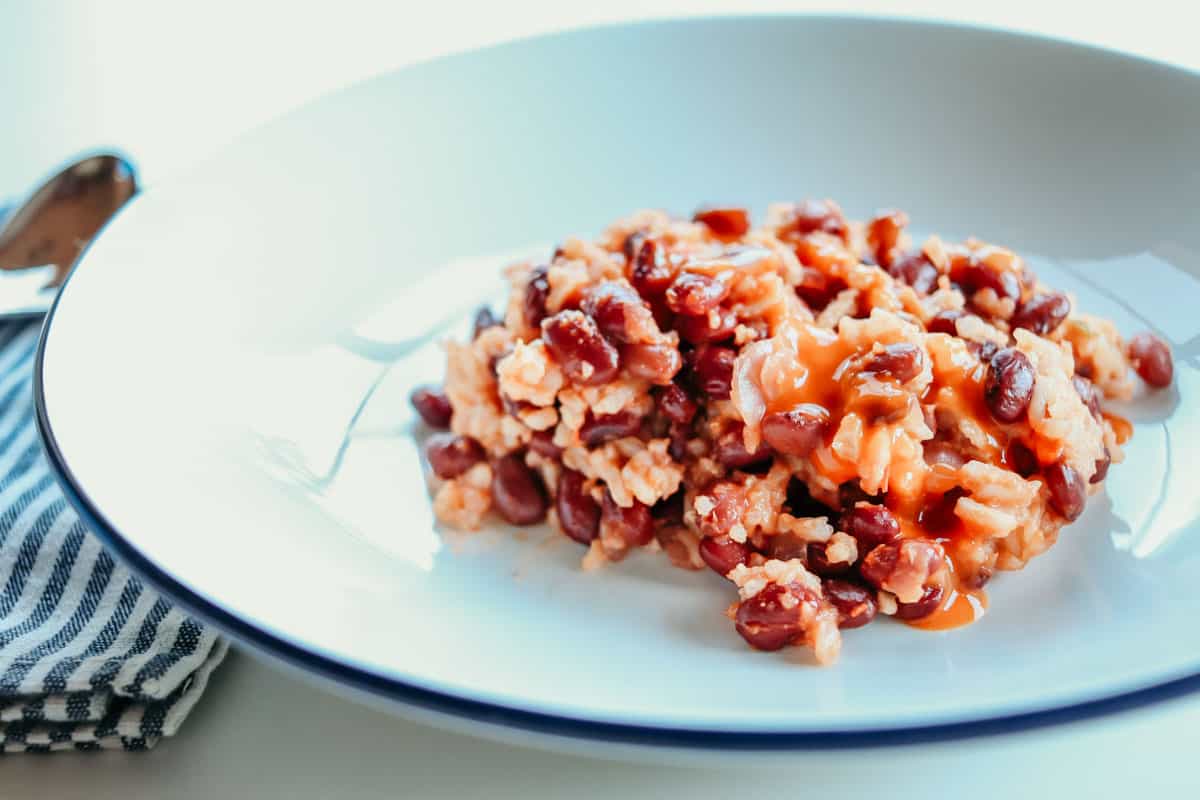
"Every culture has its own version of a one-pot rice dish - jambalaya, paella, and so on - and West Africa's take on the dish belongs with the best of them. From Senegal to Mali, Nigeria, Cameroon, and Ghana, jollof is a beloved favorite."
- Chef JJ Johnson
We're back in the kitchen and today we're excited to make jollof rice with beans.
Join us and learn more about cooking with kids and soaking beans.
If you enjoy this recipe, you won't want to miss Chef JJ's Cuban beans and rice, Afro-Asian-American gumbo, Persian shrimp with rice, Costa Rican beans and rice, braised oxtail, Hoppin' John, West African hot sauce, and Mother Africa sauce as well as kala, vegetarian gumbo, sambusas, chili with heirloom beans, and homemade salsa.
Disclosure of Material Connection: Some of the links in the post are “affiliate links.” This means if you click on the link and purchase the item, I will receive an affiliate commission. Amazon links are not affiliate links. You can read my full affiliate disclosure.
If you caught our Ethiopian Sambusas, you know we've been enjoying African cuisine lately.
Well, we recently bought Black Food: Stories, Art, and Recipes from Across the African Diaspora by Bryant Terry and it's pretty brilliant.

Black Food Cookbook
All the recipes in Black Food sound delicious, the artwork is incredible (Africa continent art by David Schmitz), and the stories are heartfelt. There's history and wisdom pouring out of every page. If that wasn't enough, it even contains a playlist for each chapter. Every cookbook should be this cool.

Bryant Terry, curator and editor of Black Food, served as the chef-in-residence at the Museum of the African Diaspora (MoAD) from 2015-2022.
Bryant is now the founder/editor-in-chief of 4 Color Books, an imprint of Ten Speed Press and Penguin Random House. Flavor + Us, by Rahanna Bisseret Martinez, is a recent publication.
Learn more about Bryant Terry.
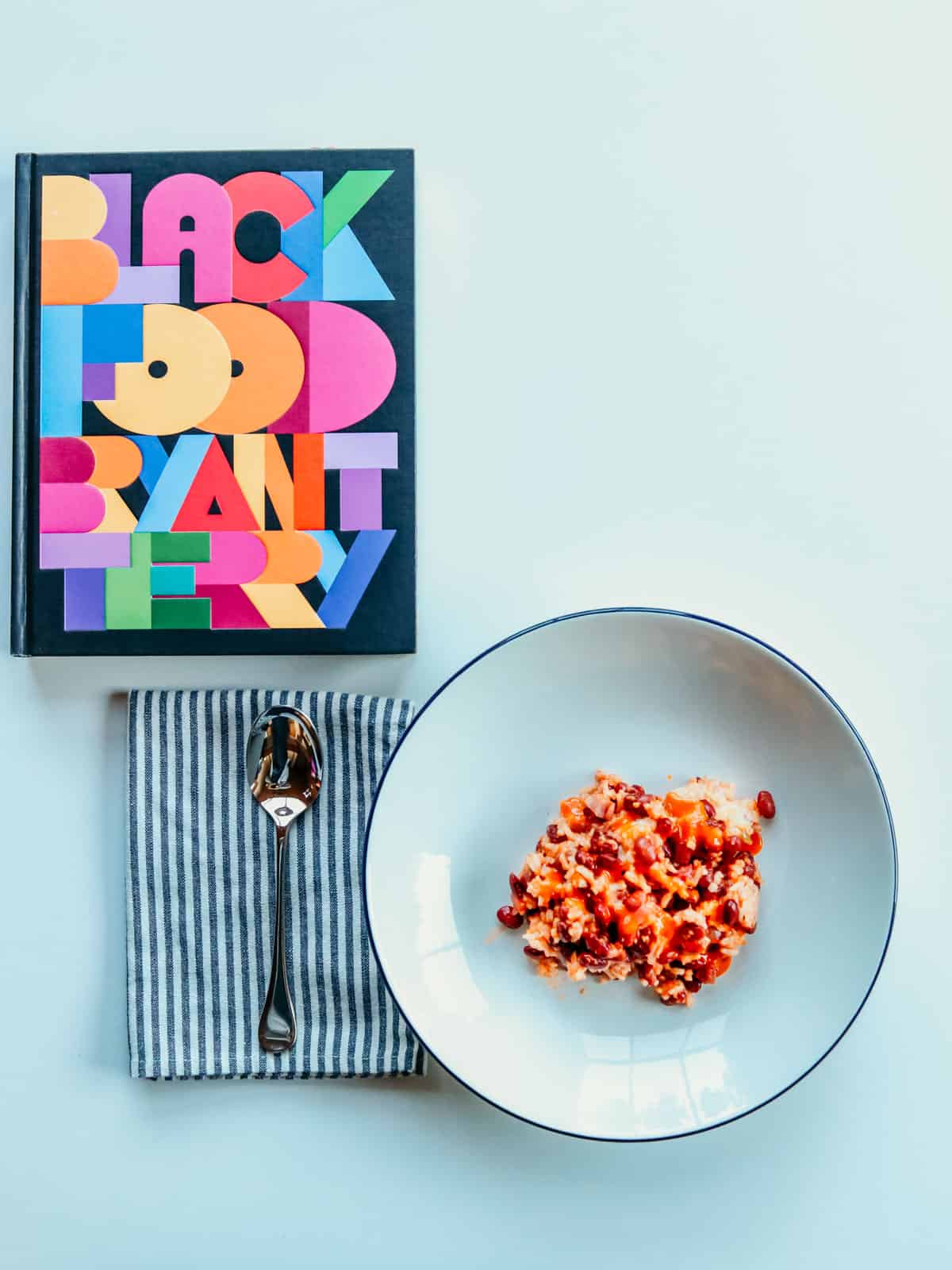
In this post, we'll be sharing how we make a delicious West African dish - Jollof Rice With Beans by Chef JJ Johnson - from the Migrations chapter of Black Food. If you're looking to elevate your game in the kitchen, this is the meal for you.
In fact, we like it so much that we made a free printable recipe with pics. You can find it down at the bottom or use the table of contents above.
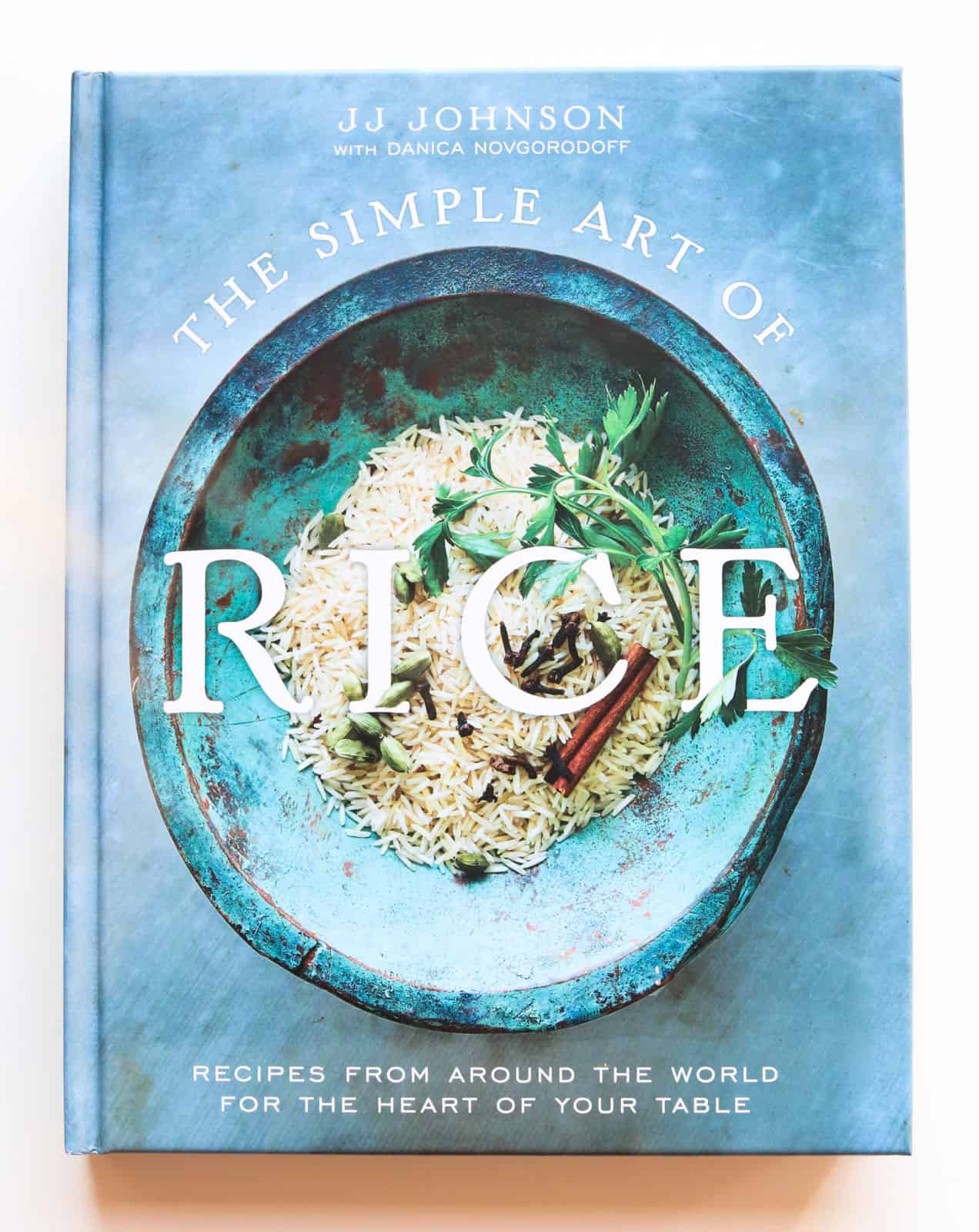
In his latest cookbook, The Simple Art of Rice: Recipes from Around the World for the Heart of Your Table, Chef JJ explores the role of rice throughout history and across cultures.
If you like this recipe from Black Food, be sure to check out this cinnamon roll pound cake by Jocelyn Delk Adams.
All recipes from Black Food can be enjoyed with an accompanying playlist. Search Bryant Terry's Black Food playlist on Spotify or grab the cookbook for more information.
Find more from Chef JJ Johnson in our shop, at FIELDTRIP, on Cleo TV, and on Chef JJ's YouTube.
Family & Kid's Cooking Resources
Beautiful and diverse cooking resources for you!
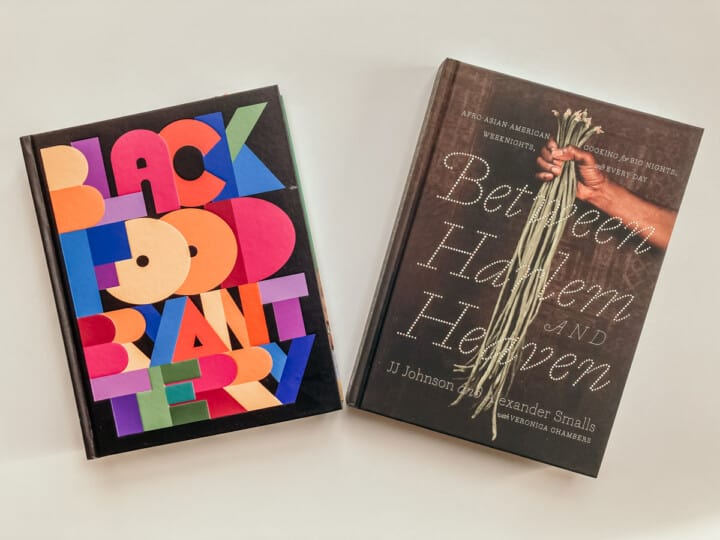
You can also stop by our shop to see more Family & Kids' Cooking Resources.
Learn more about allergies and your family.
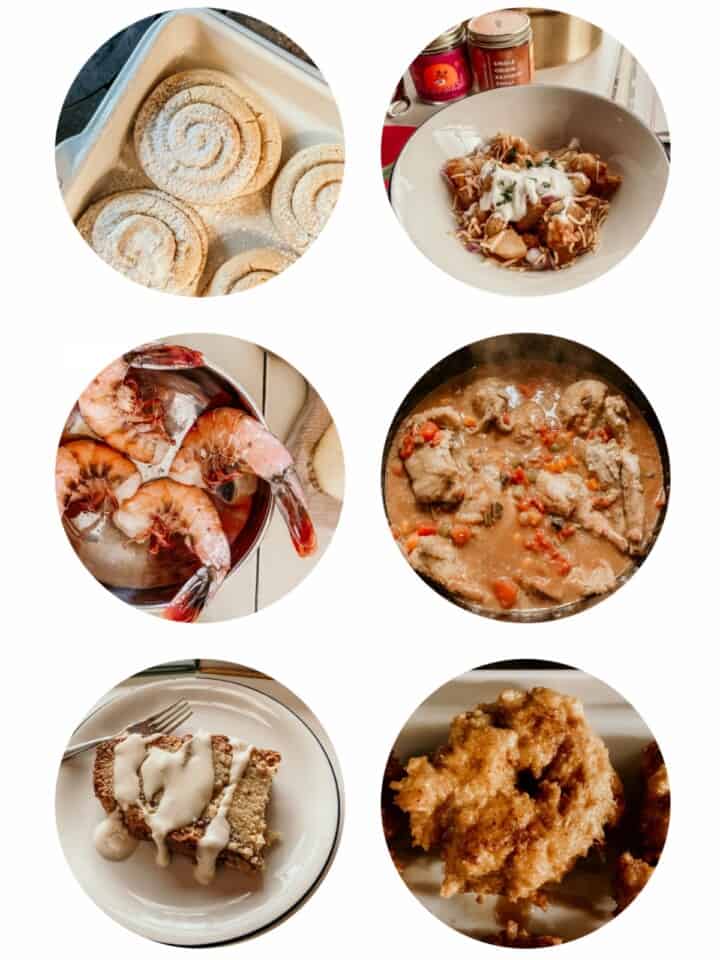
Food from Around the World: Free Cooking Lessons
Learn from some of the most talented chefs around the world!
Free Cooking Course for Families
Discover recipes for every continent! Sign up to receive free cooking lessons for the whole family. Learn from some of the most talented chefs around the world and participate in the quality practical life experiences Montessori education is known for.
Find out more about the cooking course.
Jollof is exactly what's mentioned above, a one-pot rice dish and traditional West African food. It's known for its bright red color and offers plenty of opportunities for the creative chef in your home.
Jollof rice is very flavorful and we think it's the perfect winter comfort food. It will warm you up and delight your senses at the same time.
We're going to share with you how to make Jollof Rice With Beans or Jollof Rice Pẹlu awọn ewa in Yoruba, one of West Africa's most popular languages.
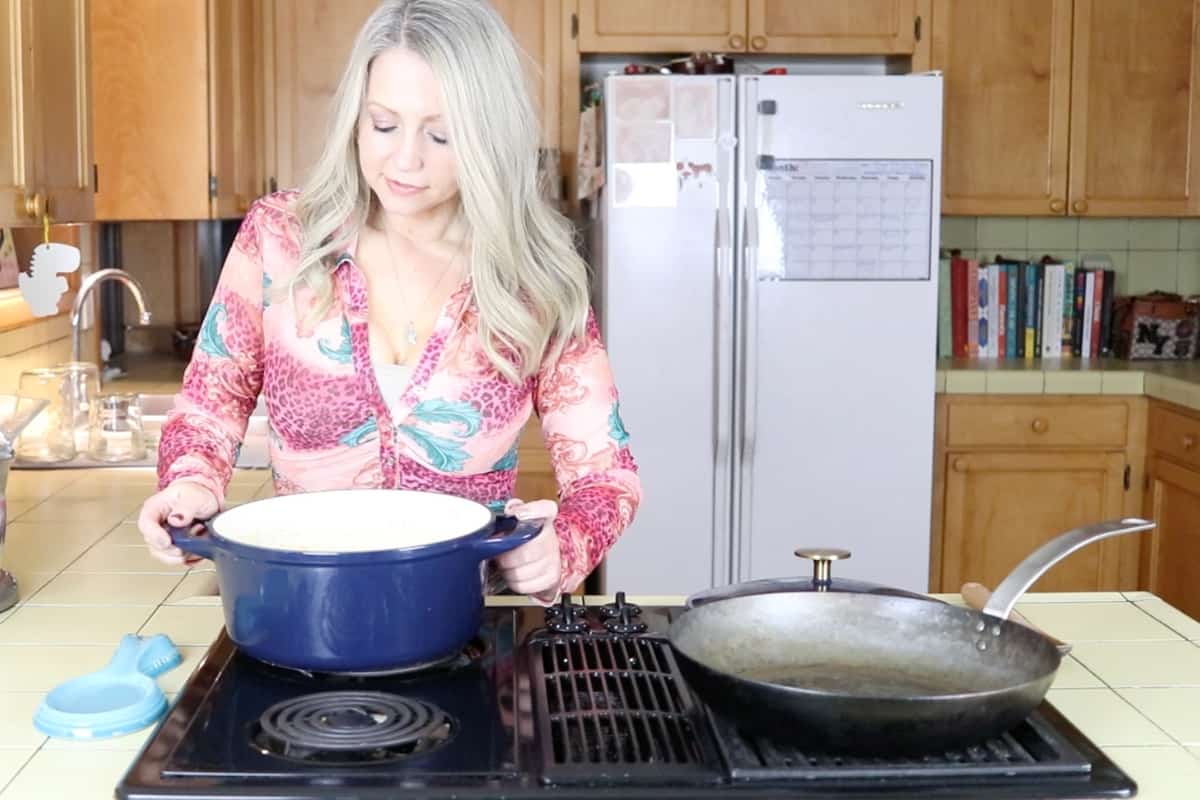
The kids are able to make everything with some planning assistance. Therefore, I think it's a great dish for preschool and up.
There are 3 different components to this West African cuisine: the beans, the tomato sauce, and the rice. Each component is simple enough on its own. However, younger children or those new to cooking are going to need more assistance with planning and organization.
Depending on the chef, there are practical life skills involved in making this dish that should keep all ages learning. Not to mention, the amazing aromas that immediately fill your kitchen will entice everyone to participate.
It can be. Or you can get creative with it. We've had it with beans as we'll show you, and we've also added ground lamb as a protein. Chef JJ Johnson also recommends adding plantains as an alternative creation.
Once it's in a bowl or the pan you'll be using, the best way to wash rice is to run water over the rice until it's completely submerged. You can even use a measuring cup if you're washing a small amount of rice.
Next, use your hands to move the rice around the bowl or pan, almost like you're sifting for gold. The water will become cloudy as you wash the rice.
Afterward, drain the water and repeat the process until the water is no longer cloudy. Boom. You've washed the rice.
This helps to remove some of the starch and any impurities that may be present related to agricultural processes.
Grab a free tutorial with pics for anyone washing rice.
You can also sit back and watch as Chef JJ washes the rice.
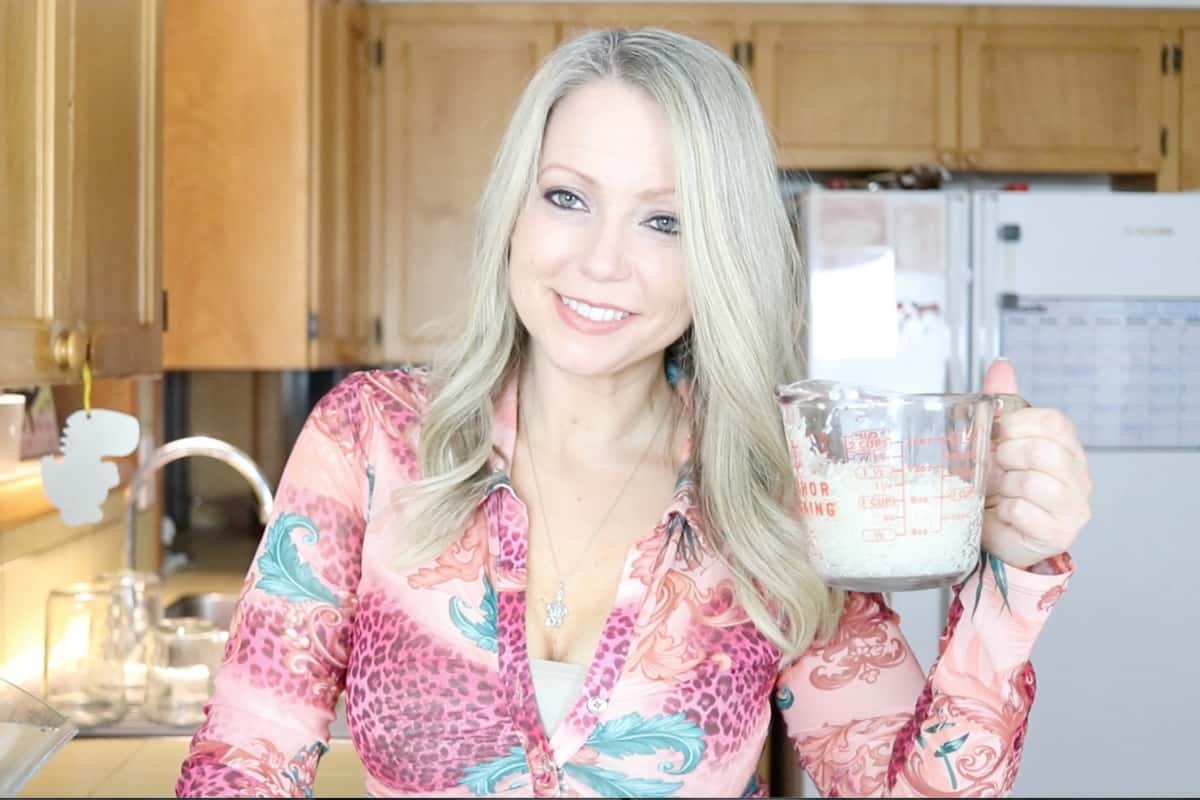
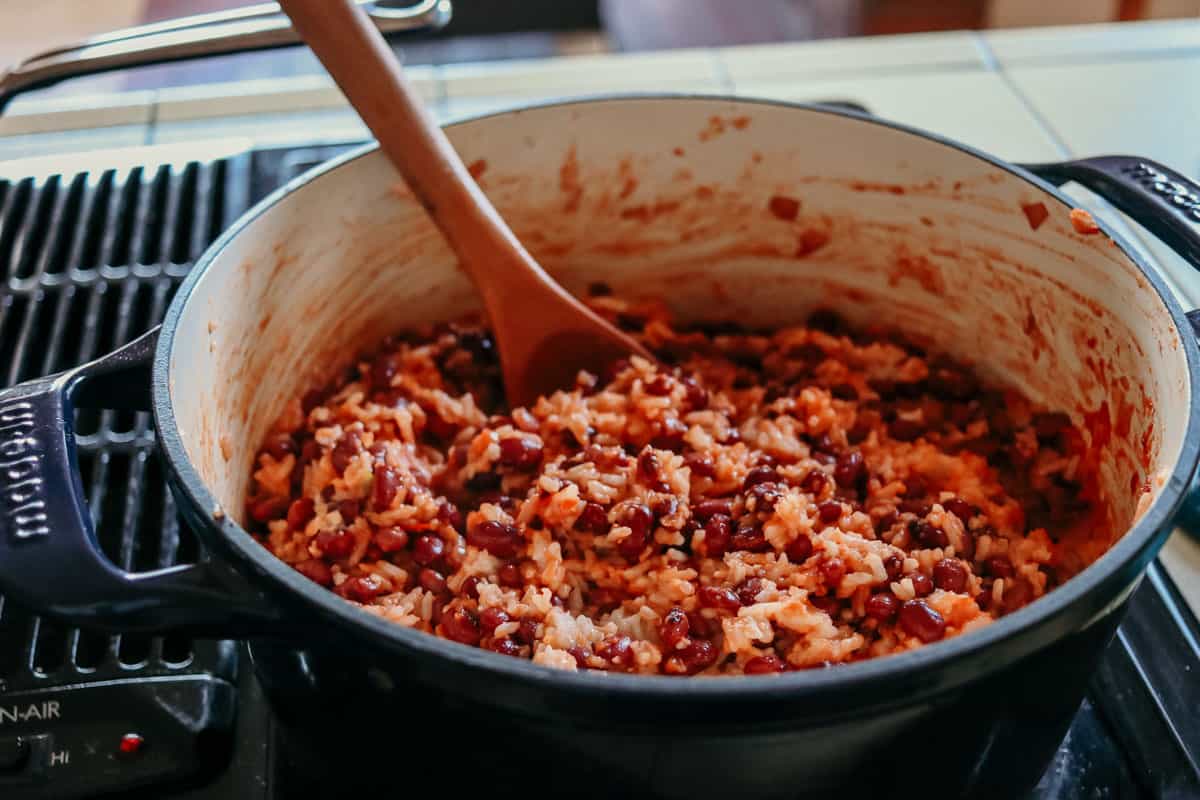
West African Cuisine: Jollof Rice with Beans
This is such an enjoyable dish to make and having an awesome cookbook to look at during any downtime is an added benefit. We also really enjoy the musical selections from the accompanying playlist.
When making this dish with kids, it's helpful to introduce them to simpler tasks first; whatever they show interest in and can reasonably manage with some assistance. Over time, their skills will develop, and they can move on to a more advanced task. Once kids have a few food prep skills under their belt, they can begin chaining tasks together during meal preparation activities.
In other words, start small and the child will build from there. You may find that you're learning right alongside them and those are the best moments.
Our dish is fairly close to the recipe in the book, except for a couple of substitutions. We also later added ground lamb as a variation. As I mentioned earlier, feel free to get creative with your kids. This is how we make it.

Ingredients
- Spanish Onions
- Olive Oil
- Garlic
- Ginger
- Bird's Eye Chiles (or your favorite chiles)
- Tomato Paste
- Plum Tomatoes
- Domingo Rojo Beans - we like these beans because they taste delicious and we can purchase them alongside some of our other favorite varieties from Rancho Gordo. When cooked, they create a beautiful, tasty red broth that can be reused. You can also use Red Kidney Beans, or Adzuki Red Beans for this recipe.
- Water
- Jasmine Rice - Lotus Foods says this organic white Jasmine rice "is called Phka Malis, which in Khmer language means beautiful garland of flowers because of its delicate floral aroma. It has a soft, slightly sticky texture and fast cooking time."
- Salt
- Black Pepper
Equipment
- Apron
- Prep Bowls
- Cutting Board
- Butcher Block
- Child-Friendly Knife
- Santoku Knife
- Box Grater (optional)
- Measuring Spoons
- Measuring Cup
- Wooden Spoon
- Saucier or Medium Saucepan
- Dutch Oven or Large Saucepan
- Blender
- Learning Tower as needed
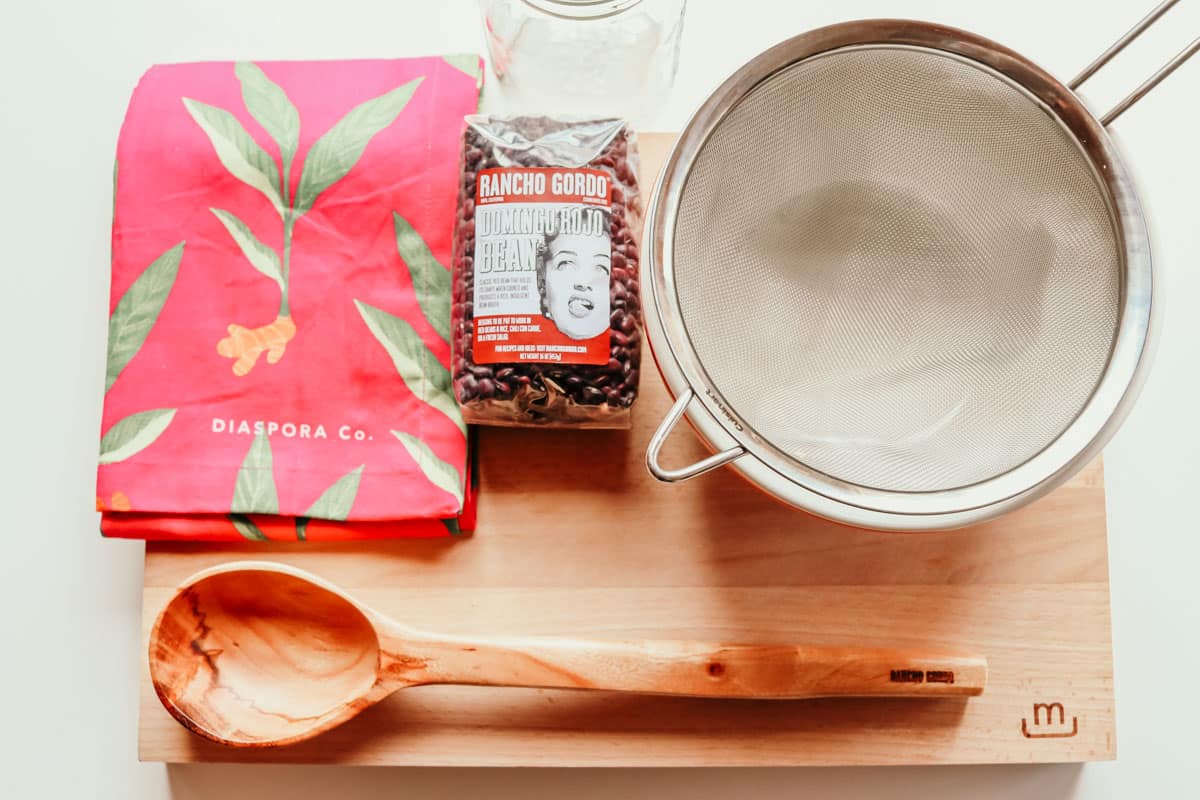
Soaking the Beans
If you want to cut down on the cooking time for this recipe, you can soak the beans ahead of time. Rancho Gordo suggests soaking Domingo Rojo Beans for 2-6 hours prior to cooking them.
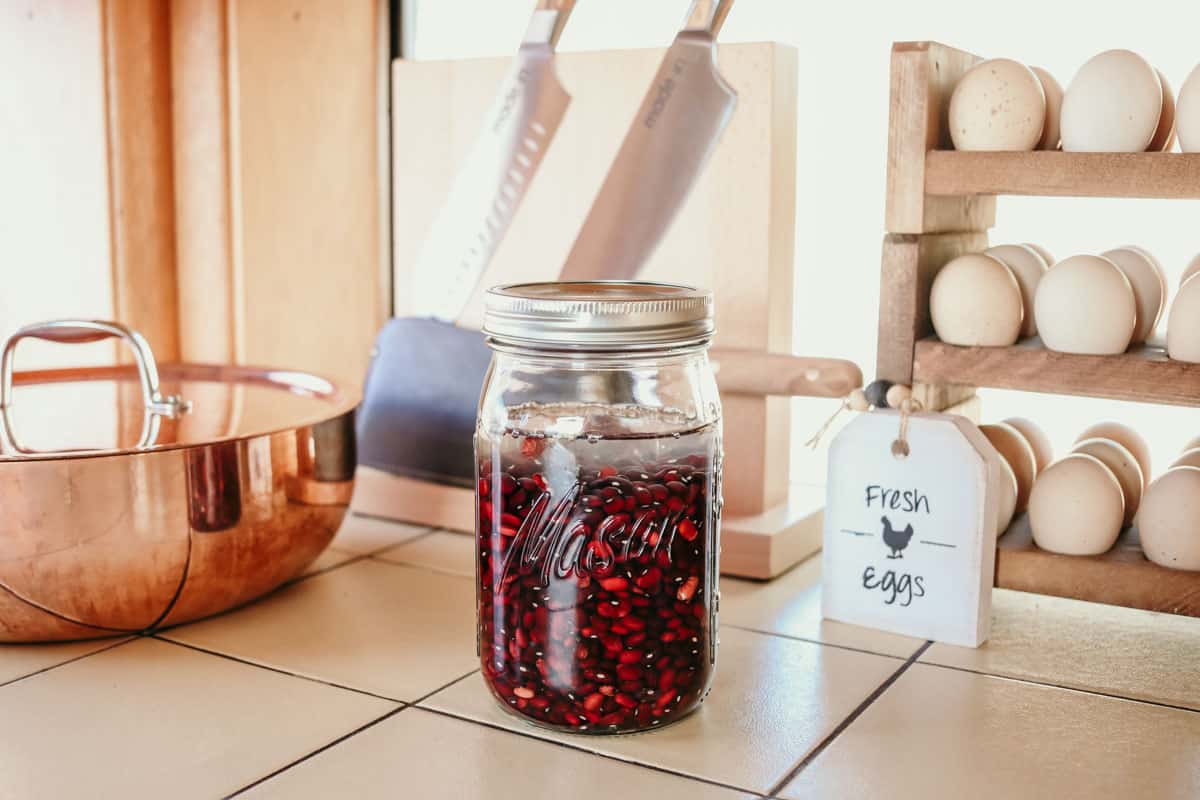
Learn more about soaking your beans.
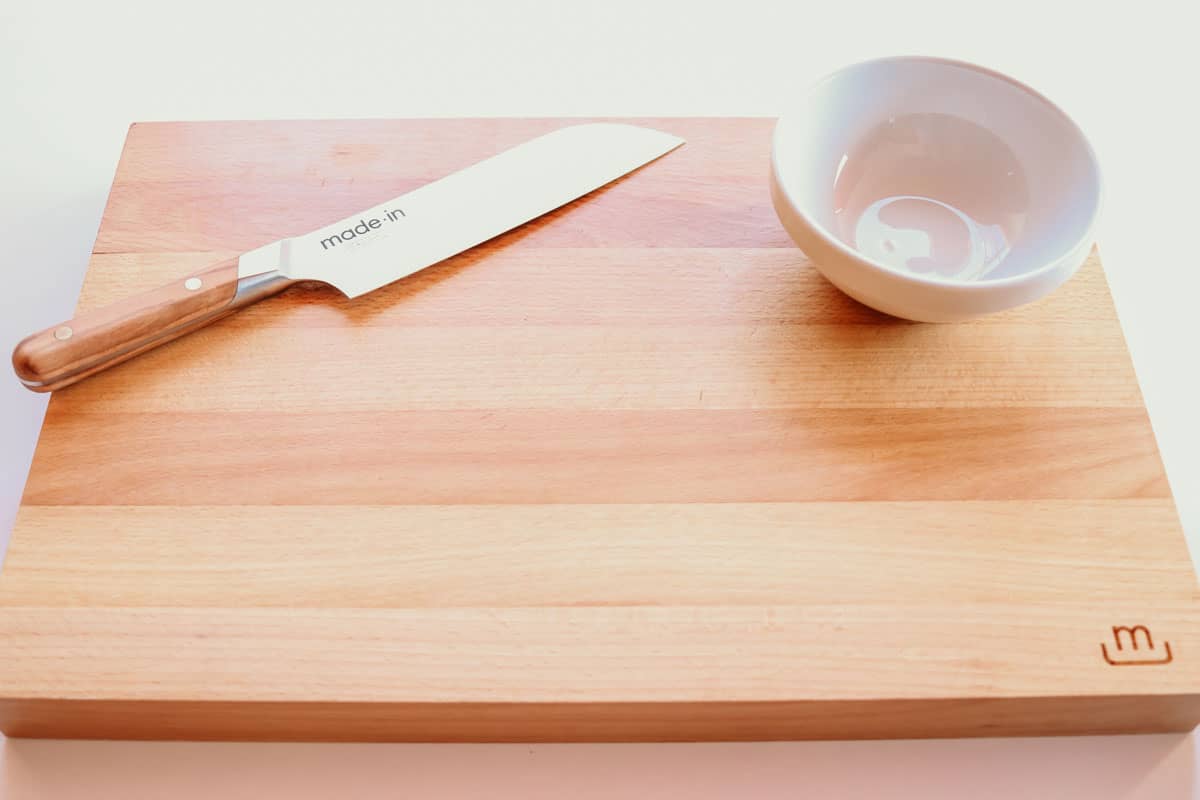
1. Prep the Ingredients for Making the Beans and Bring to Stove
Chop 4 garlic cloves, 1 chile & 1 onion using a knife and cutting board. Seed and chop the chile yourself or provide a brief reminder about handling chiles and touching sensitive areas such as eyes. Handwashing after chopping chiles has made for a painless experience in our home.
Bring the items to the stove along with 1 cup beans, and 4 cups cool water. Assist the child as appropriate for their abilities. We use a Learning Tower at the stove to promote independence.
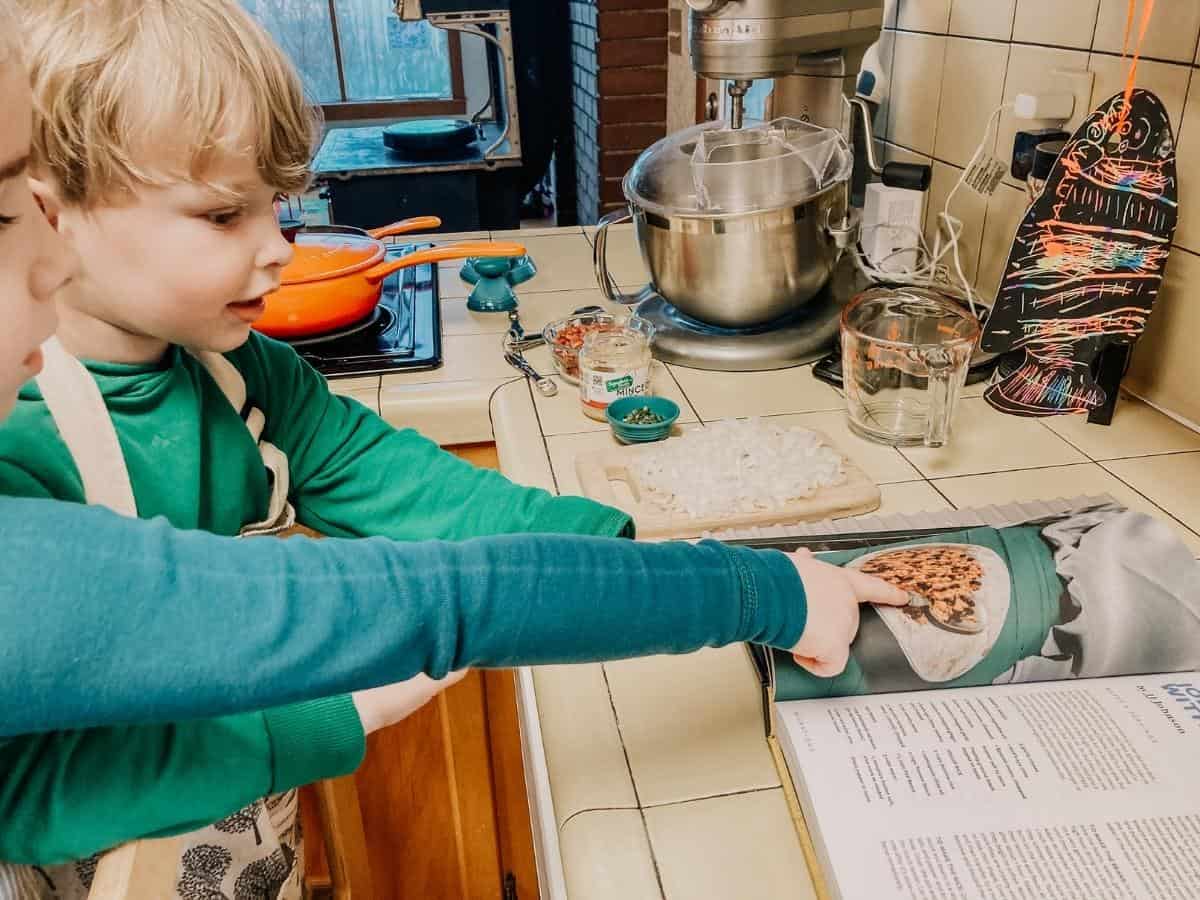
Don't forget the cookbook for instructions. Our kids immediately noted the reddish color of the dish pictured in the book and asked if it was because of the tomatoes.
If you decide to make this West African cuisine and you enjoy it, you may want to get the book in order to receive the full benefits of the experience. We enjoy having it as part of our Books for Africa Continent Studies.

2. Add the Water and Beans to a Medium Saucepan
Turn the stove on high heat. Add the water and the beans to a medium saucepan.
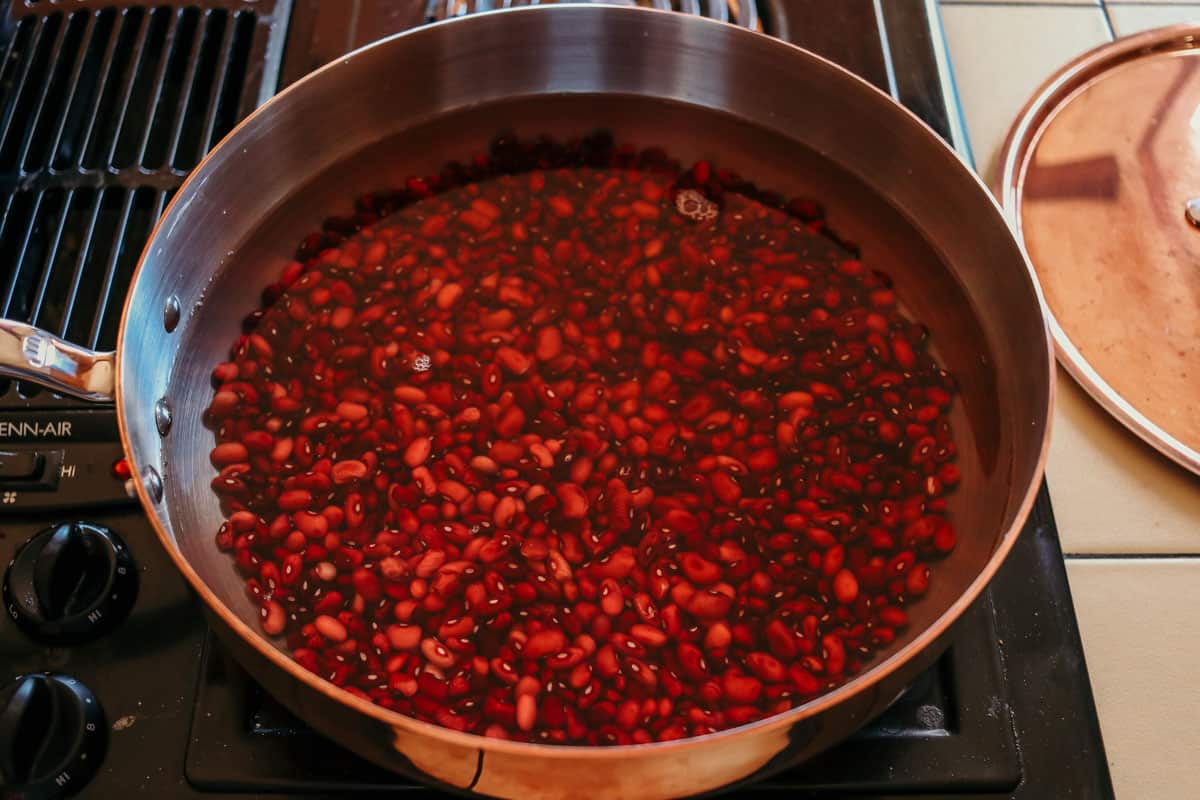
We put our Learning Tower close enough for our kids to reach but with a little bit of space between them and the stove.
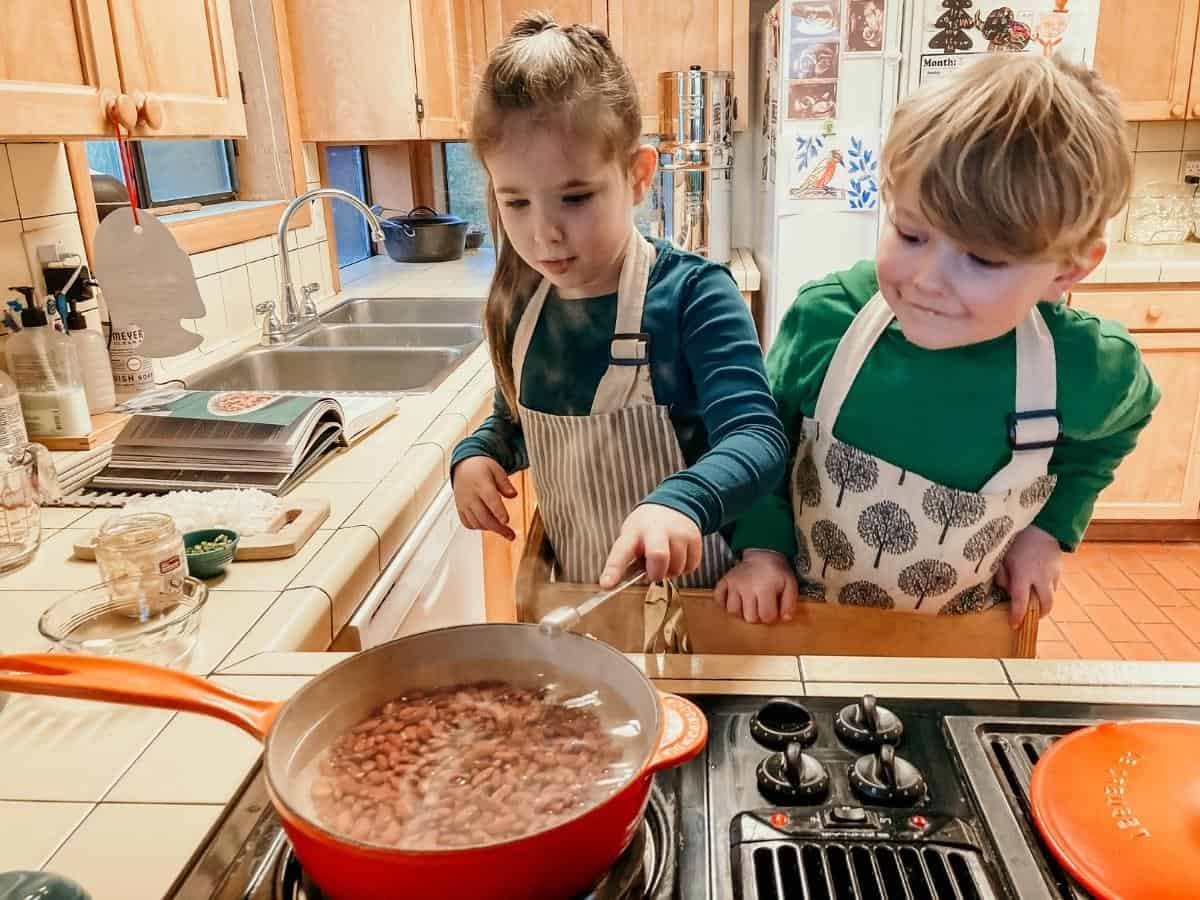
3. Add Garlic
You may notice we have a lot of the kids' artwork in the kitchen. My friend Julie over at Nature Inspired Learning makes printables for kids and the bird coloring pages hanging on the fridge are one of our favorites.
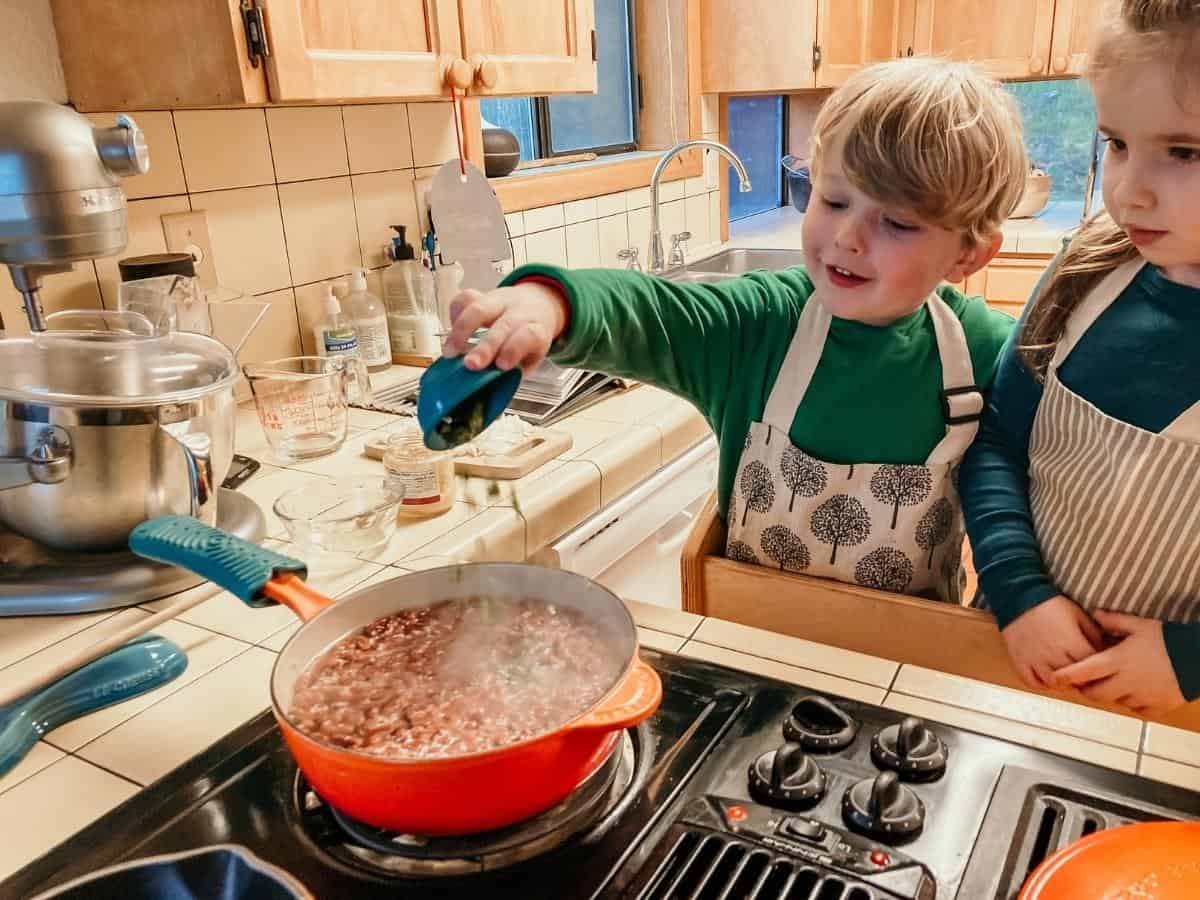
4. Add the Chile and Onion
If you like chiles, you should try this chaat recipe.
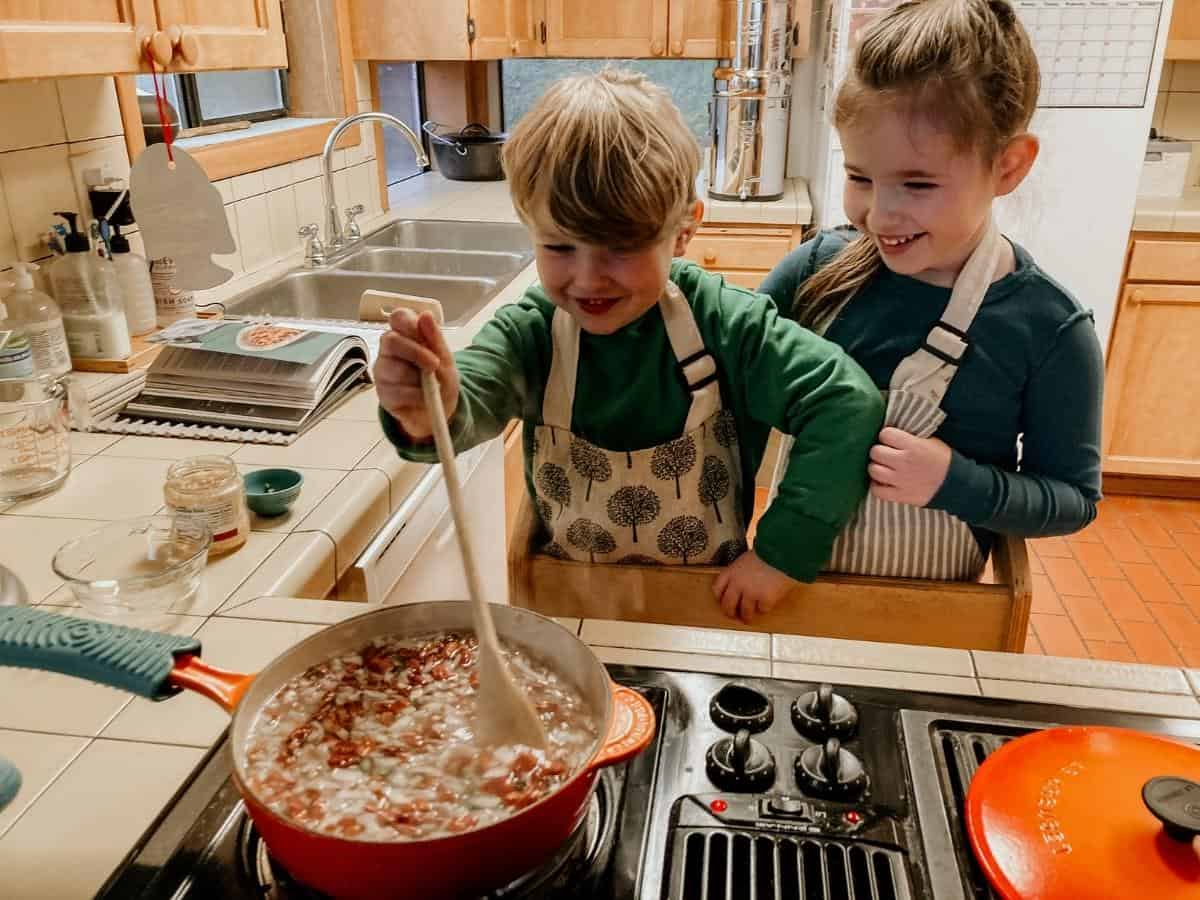
5. Give it a Stir
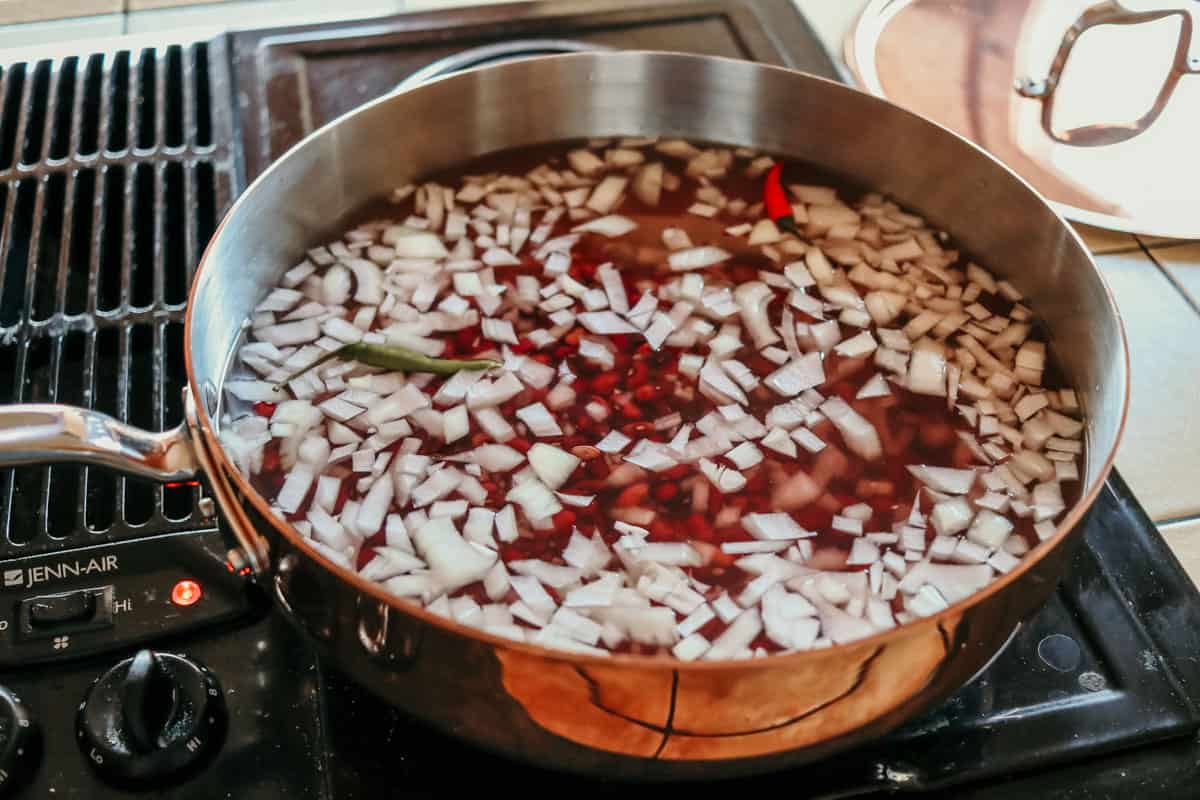

6. Bring to a Boil, Reduce Heat to Low, and Simmer
The kids loved this part. The bubbles and steam are exciting while the beans transform into a wrinkly version of themselves.
Looking for more fun with beans? Check out this three sisters bean stew recipe.
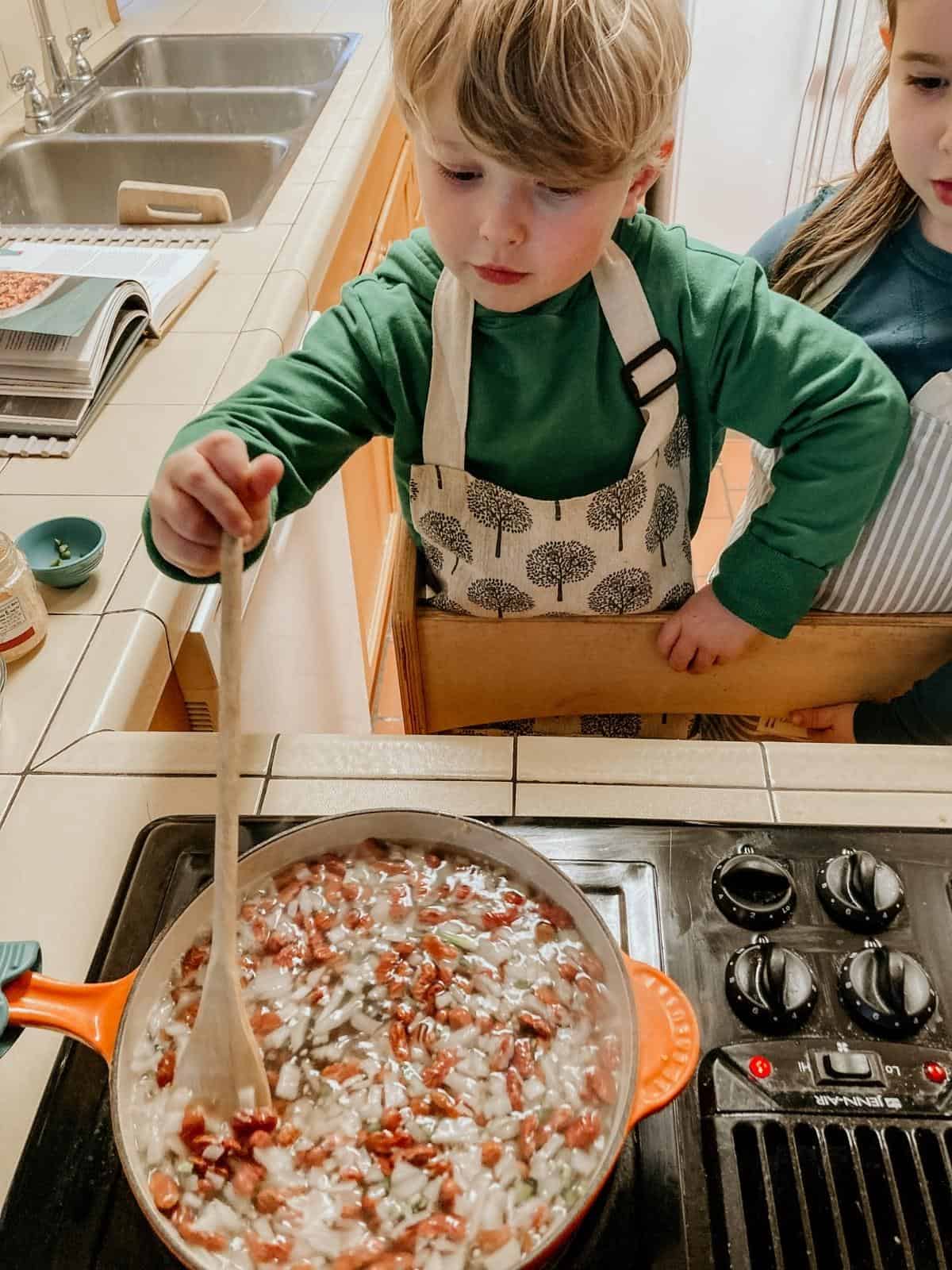
7. Cook until Tender
Cook for about 1 ½ hours, stirring occasionally, and add water as needed to keep the beans submerged. Taste frequently for texture and flavor after 1 hour. When soft, season with salt and pepper.
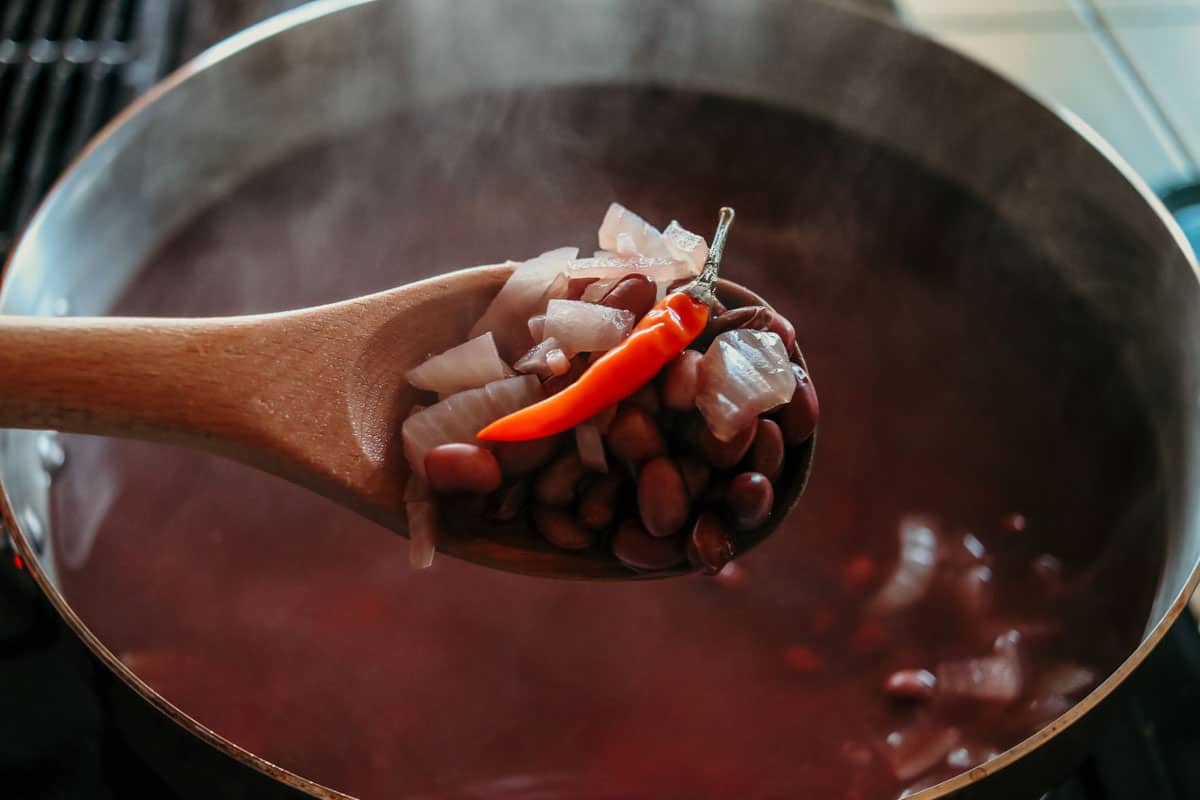
Remove from heat when soft and before they lose their shape. Leave them in the pan to cool. Turn off the stove and remove any chiles.
At this point, you can move on to prepping the tomato sauce. Also, it's a great opportunity to dive into the cookbook for more African cuisine.
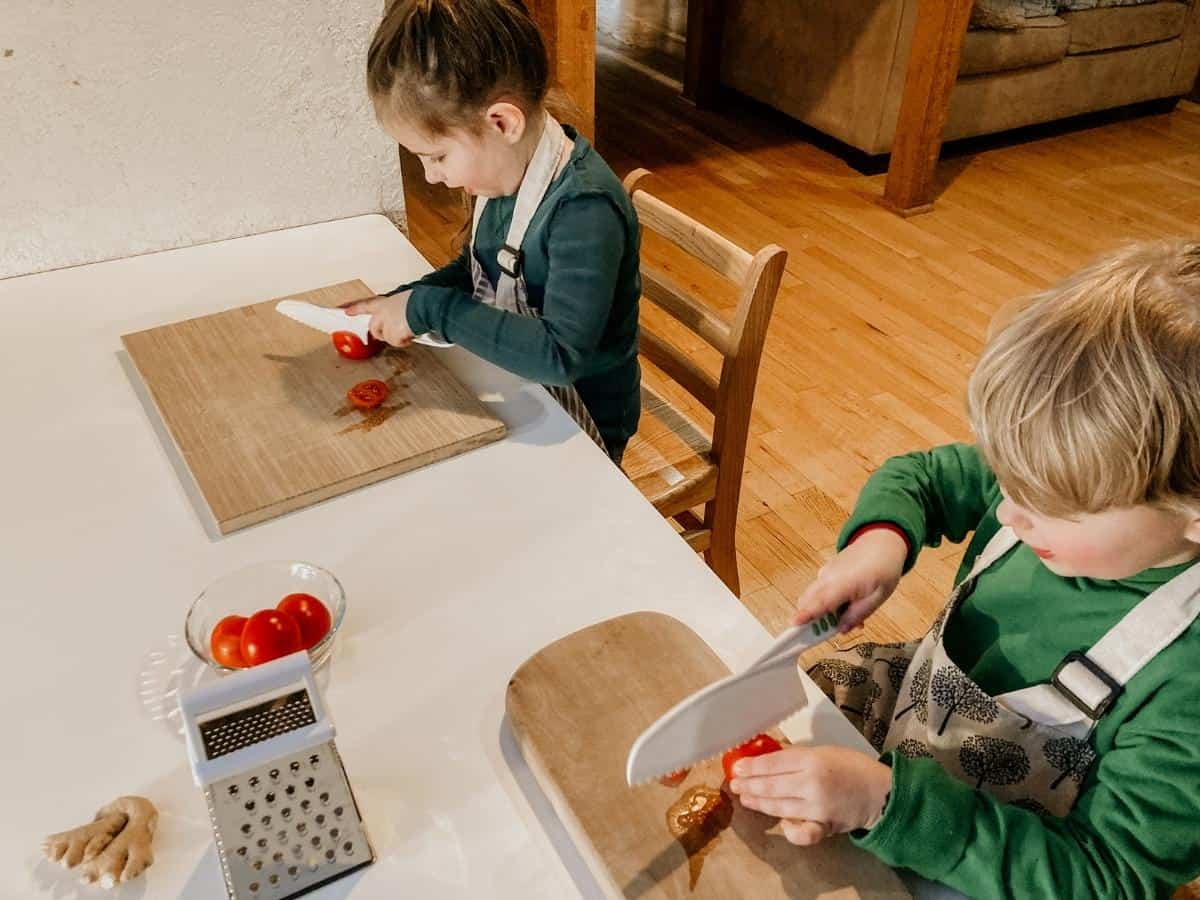
8. Chop Items for the Tomato Sauce
While the beans are cooking you can prep the tomato sauce. Chop the remaining ½ onion, tomatoes, 3 garlic cloves, and 2 chiles.
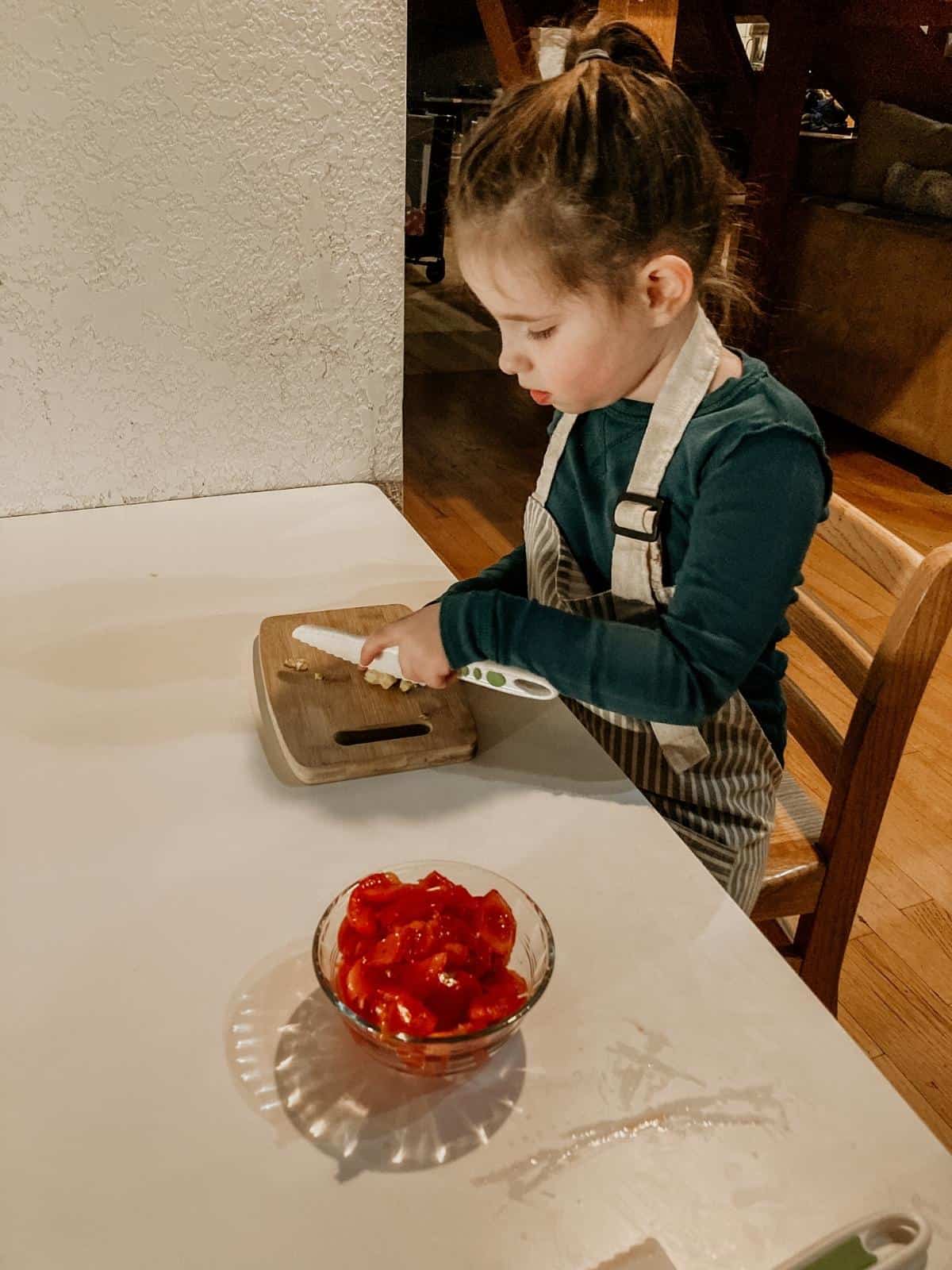
9. Peel and Chop Ginger
Chop enough ginger for 1 teaspoon. Make sure to peel the ginger before chopping. You may need to assist with this task.
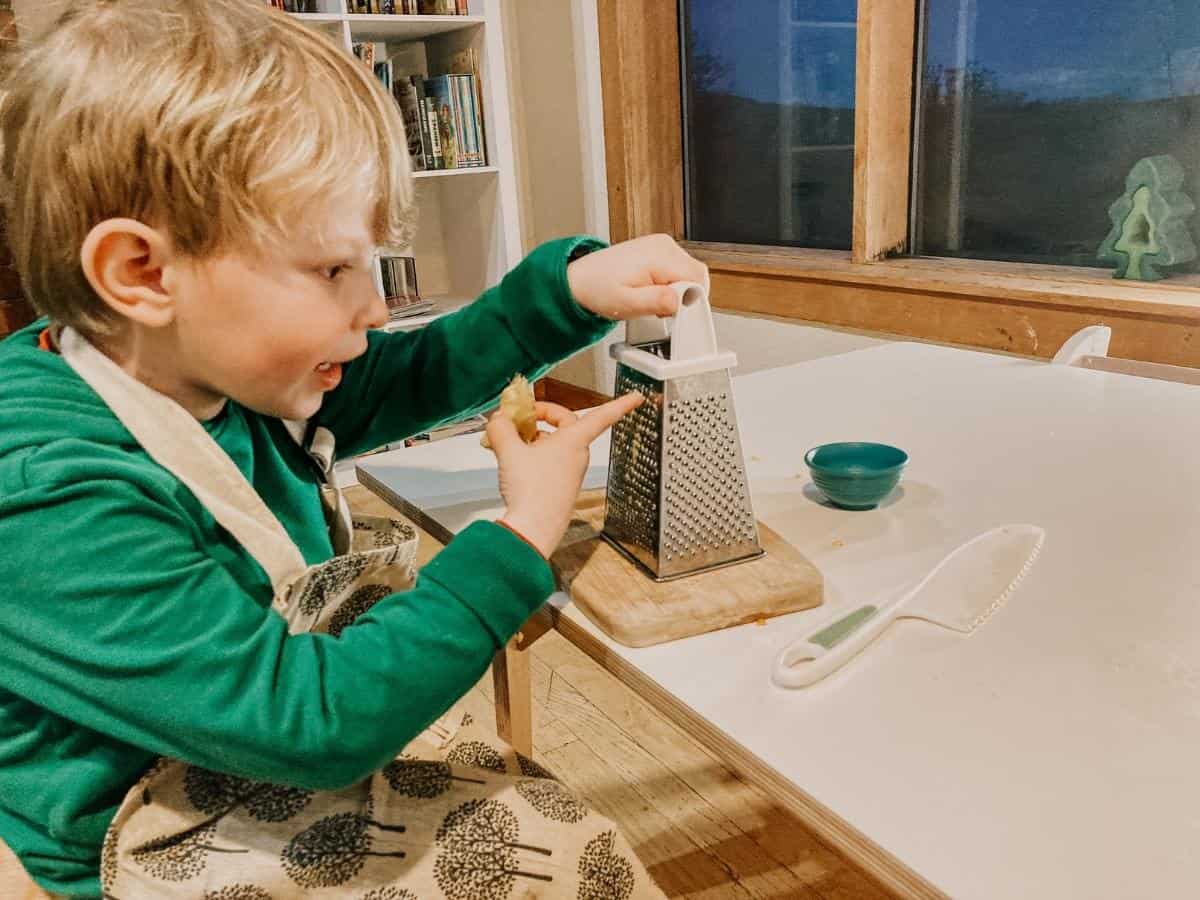
Alternatively, you can also grate the ginger. Noah is all about the box grater right now and he uses it at any opportunity he has.
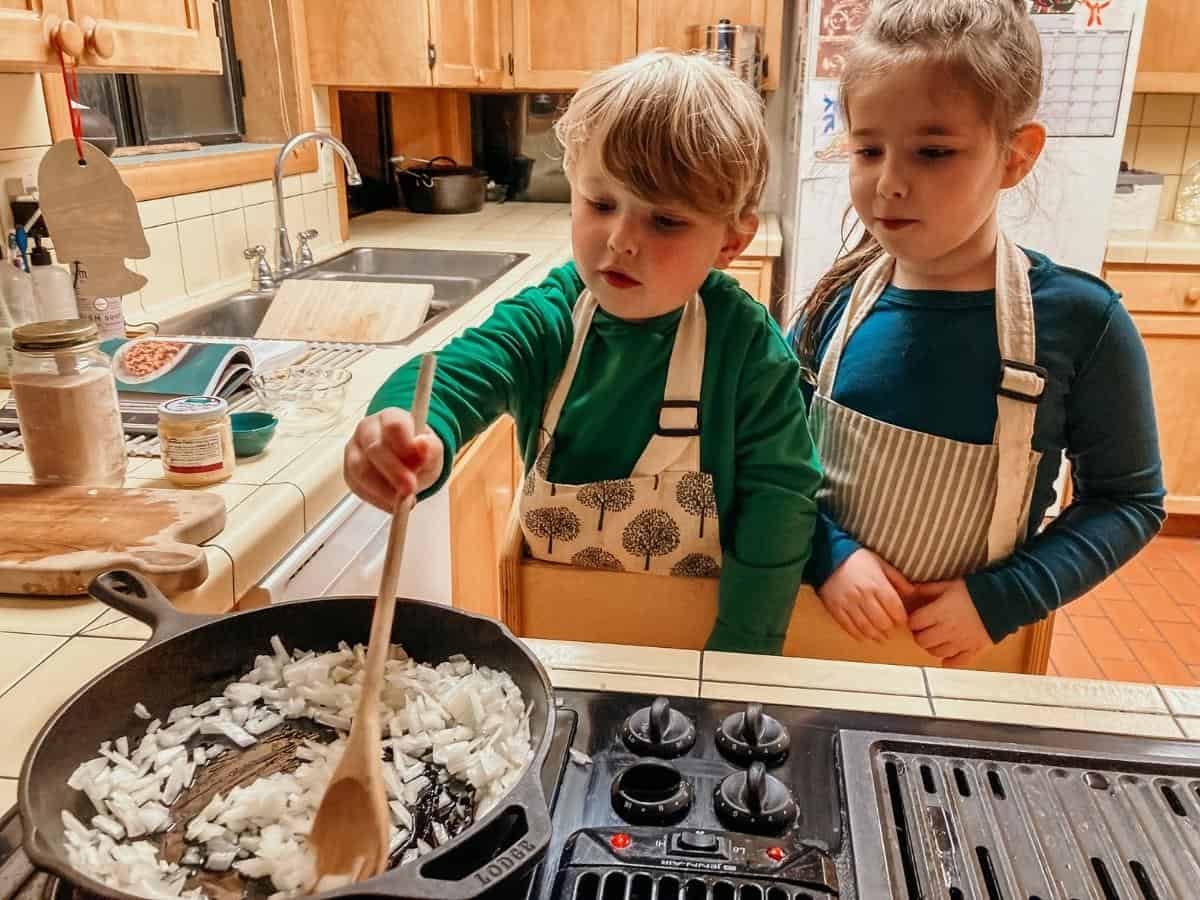
10. Heat Oil in Pan on Medium Heat and Add Onion
Head back to the stove and cook the onion in 2 tablespoon of oil over medium heat. Add some salt and cook until the onion is translucent, 3-5 minutes.
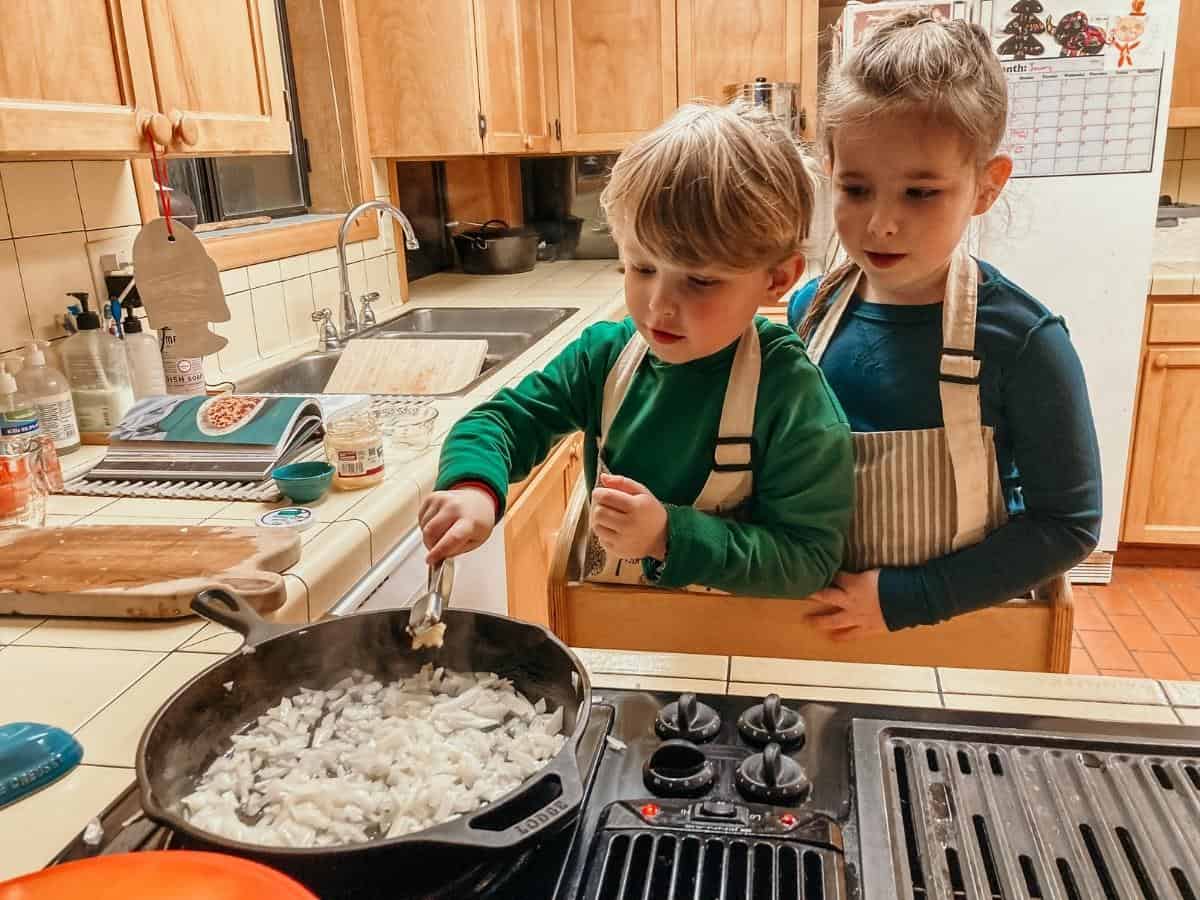
11. Add Garlic, Ginger, and Chiles
Cook for 2 minutes or until soft.
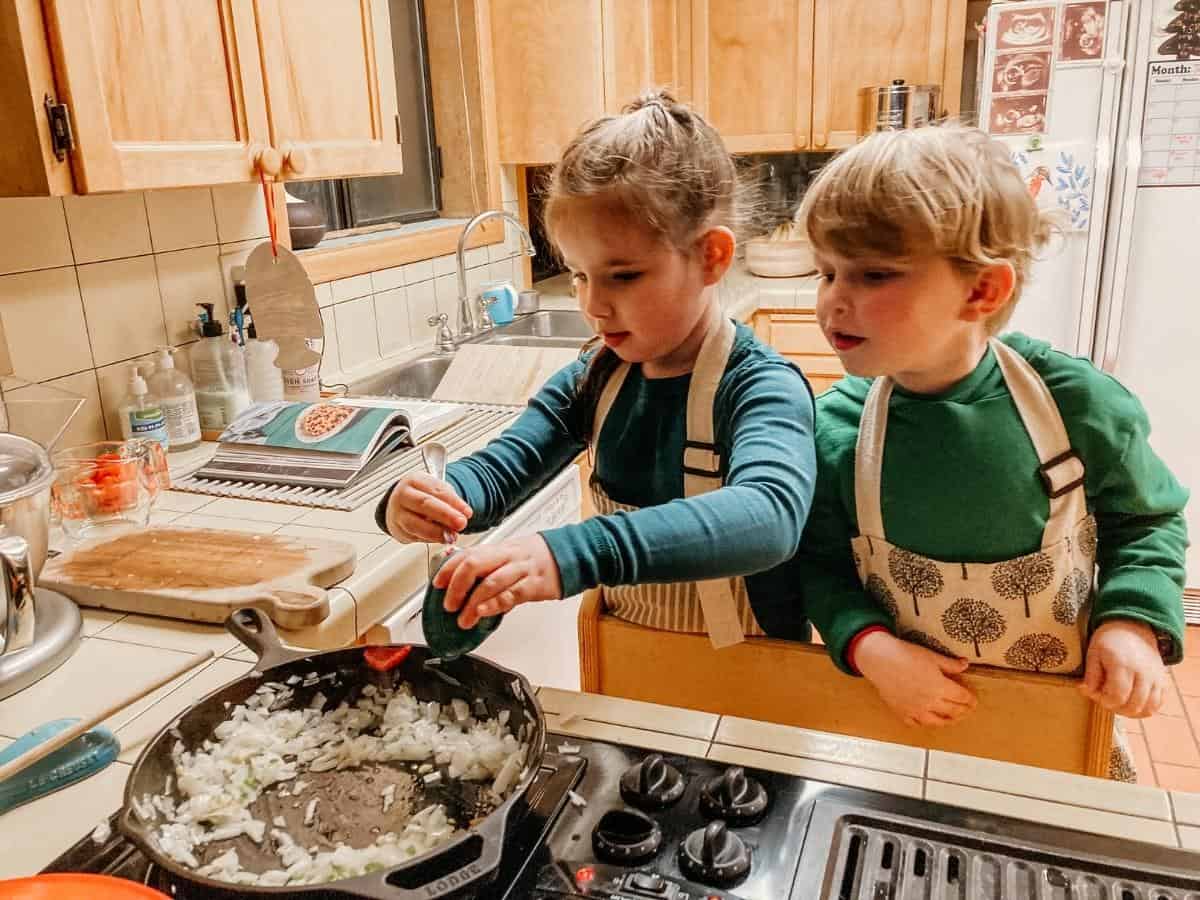
12. Add Tomato Paste to Make Jollof Rice
Stir and cook for 5-8 minutes. Turn off the burner.
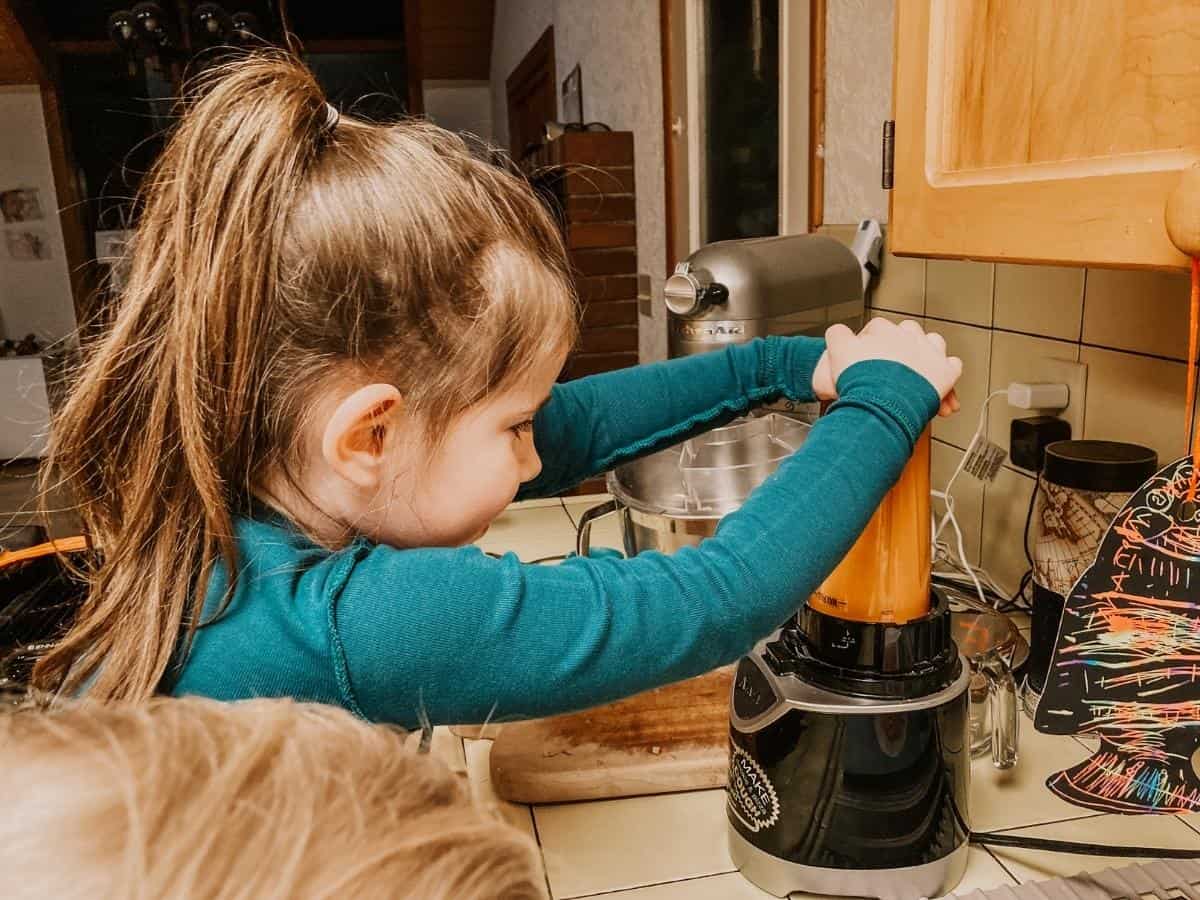
13. Transfer to a Blender
Pulse to combine. Add the tomatoes to the blender and puree. Add water if too thick and season with salt. Using a blender is a ton of fun and our oldest really enjoyed this part.

Here's the beautiful red sauce. Kaia and Noah were really happy to see that it matched the bright red in the picture.
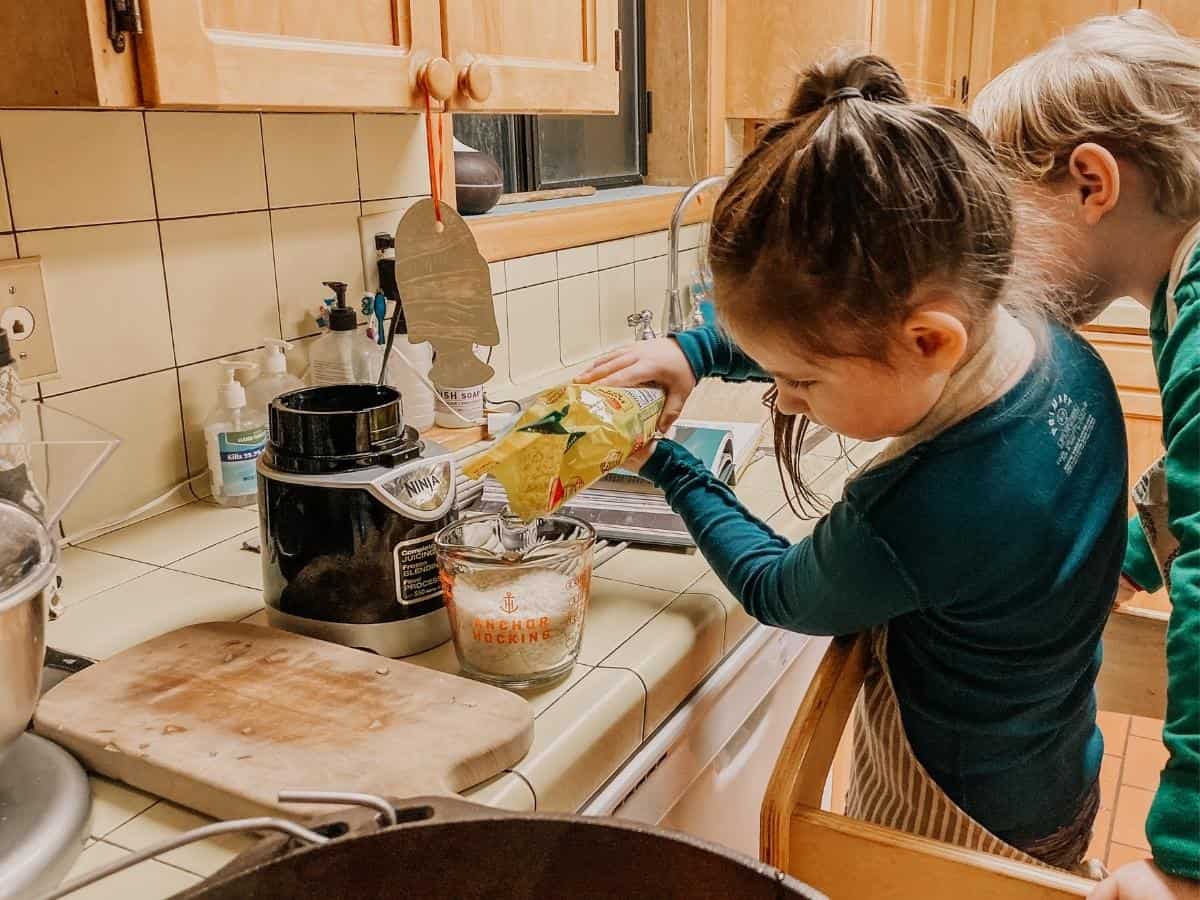
14. Measure the Rice
This West African dish still needs rice. Measure the rice using a measuring cup.
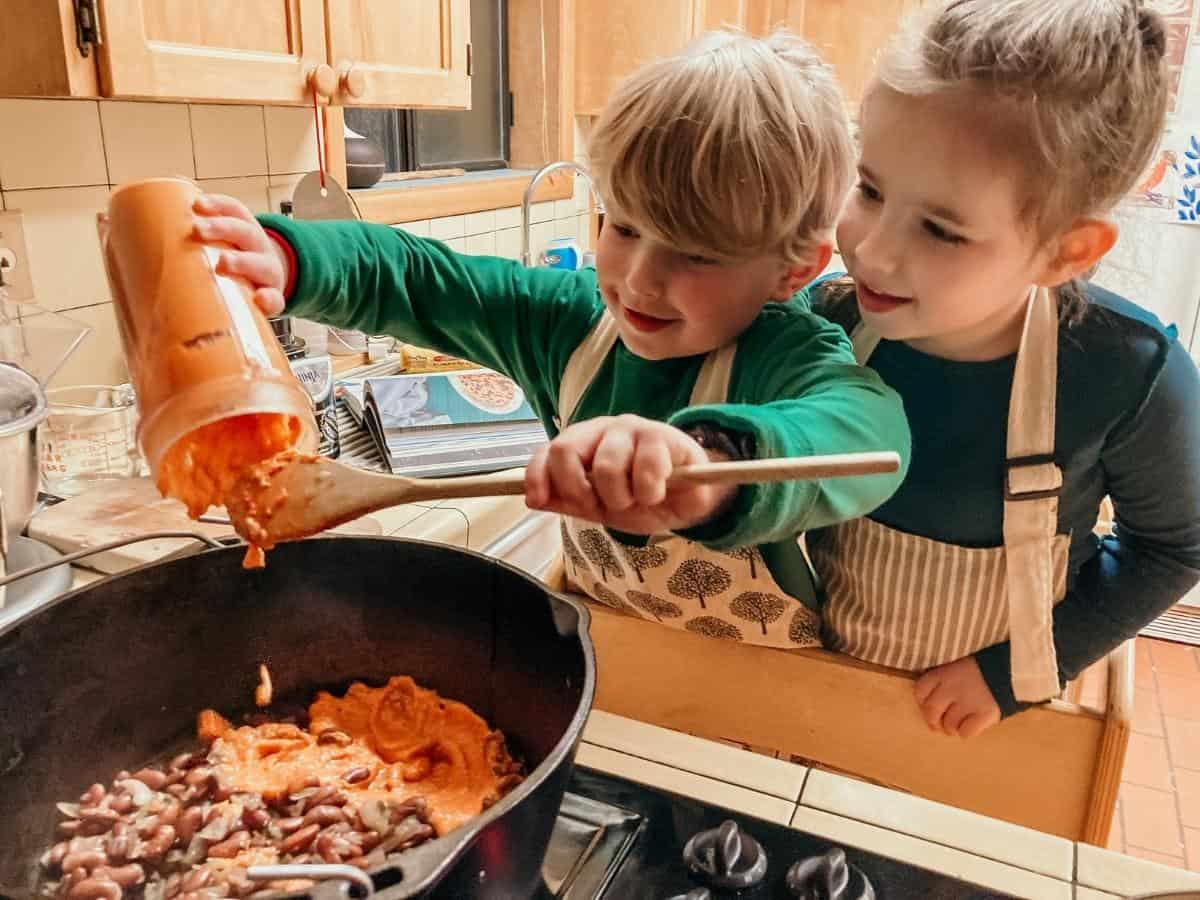
15. Add Rice, Oil, Tomato Sauce, and Beans
After the beans and sauce are ready, the last part of creating this Jollof Rice dish is combining them with rice.
Wash your rice prior to adding it to the saucepan to remove some of the starch as well as any impurities. See above for the best way to wash rice.
Add the rice, the remaining oil, tomato sauce, and beans to a large saucepan or dutch oven.
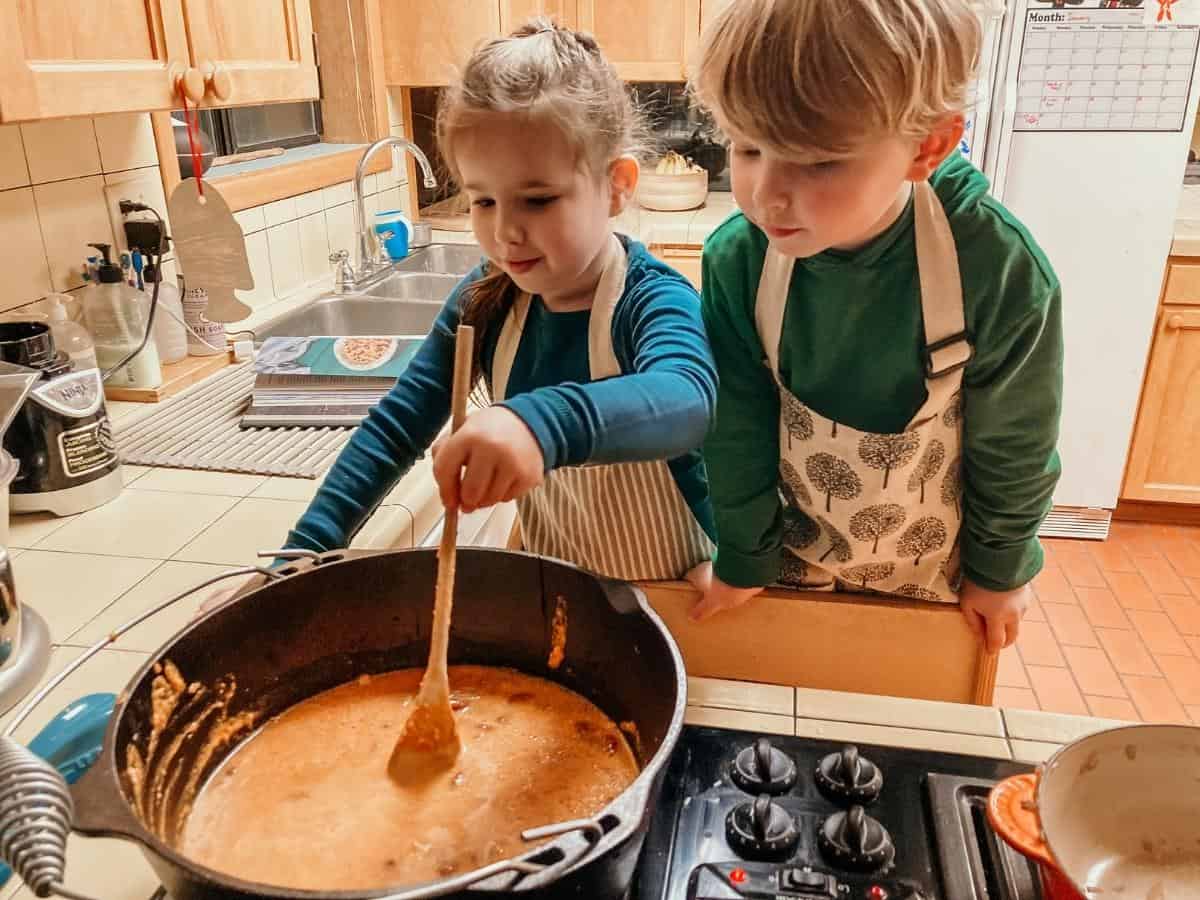
16. Add Water, Salt, and Black Pepper to Jollof Rice
Add water, salt, and black pepper and simmer over medium heat. Cover and cook for approximately 40 minutes, until the rice is tender.
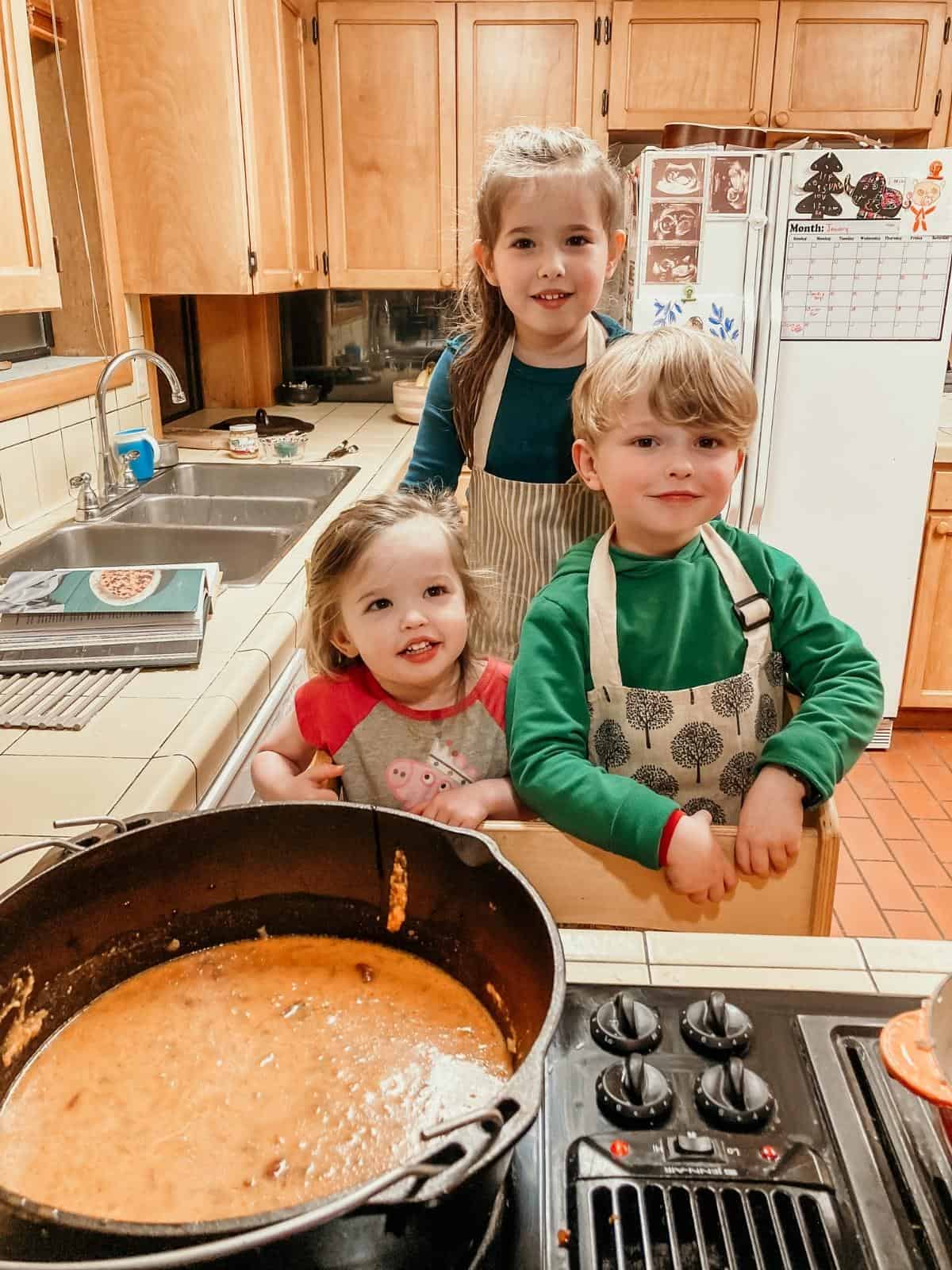
Katalina woke from her nap around this time and couldn't wait to see what was cooking. She was excited to find jollof rice cooking on the stove.
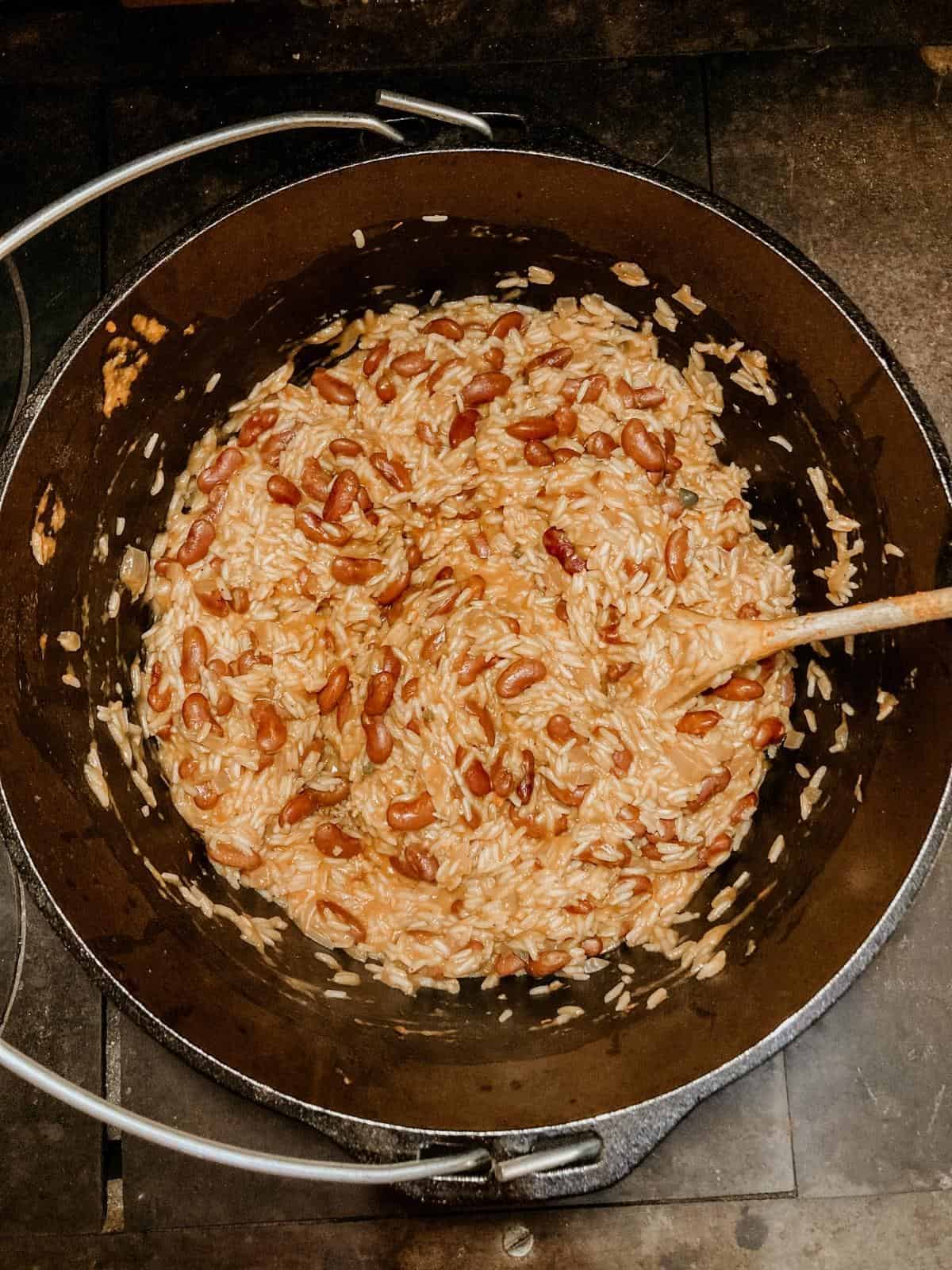
17. When Jollof Rice is Finished, Sit Covered for 10 minutes
Fluff with a fork and serve. Beautiful and delicious. We later added some ground lamb as well and it was awesome.

Such a tasty dish and an incredible way to learn more about West African cuisine.

Conclusion for West African Cuisine: Jollof Rice with Beans
We hope you've enjoyed seeing how we make Jollof Rice with Beans in our homeschool. I can't reiterate enough how much having the book really adds to the whole experience.
If you're a homeschooler, this cookbook has so much to offer. It is as gorgeous on the inside as the cover art by George McCalman is on the outside. I know we'll be enjoying it for years to come as we study Art, Language, Poetry, History, Science, Fundamental Human Needs, and more.
In my opinion, Black Food by Chef Bryant Terry is a must-have book for every homeschooler's kitchen as it embodies the soul of cosmic education. If you don't have the book, we hope you find this useful and enjoy making this recipe with your family.

Free Jollof Rice With Beans Recipe
For you to try at home!
Free Jollof Rice With Beans Recipe for Pre-Readers and Up
Grab your free printable recipe cards above. Kids can gather ingredients using the ingredient list, gather their equipment with the tools list, and prepare the meal using the step-by-step recipe cards, with assistance as needed.
The cards are easy to use, include pictures, and encourage confidence and independence in the kitchen. They also make an excellent addition to your Montessori continent box for Africa.
Montessori Continent Boxes
Explore every continent with these solid maple hardwood boxes.
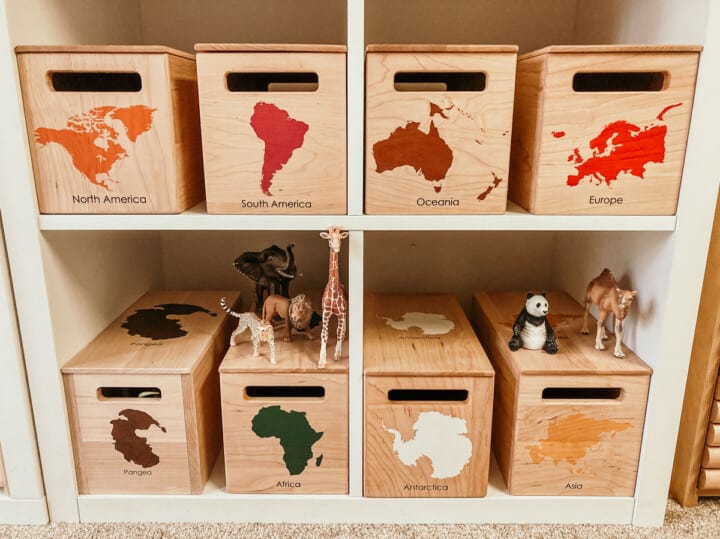
More Africa Educational Resources
Save $15 on your first Waseca Biomes purchase here.
More Practical Life in the Kitchen
- Chocolate Bison Chili: An Indigenous Food Experience and Free Printable
- Xinxim de Galinha, Bahian Chicken Stew and Free Printable
- Asian Dumplings
- Ukrainian Welcome Bread
- Aussie Barbecue Prawns
- Family and Kids Cooking Resources: Different Food Cultures
- Easy Baking for Kids Using a Visual Recipe
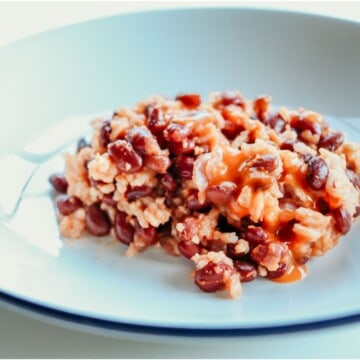
Jollof Rice with Beans, Jollof Rice Pẹlu awọn ewa: A Taste of West African Cuisine
Equipment
- Box Grater optional
- Medium Saucepan
- Dutch Oven or large saucepan
- Learning Tower as needed
Ingredients
- 1 ½ Spanish Onions
- 3 tablespoons Olive Oil
- 1 teaspoon Ginger chopped/grated
- 3 Bird's Eye or your favorite seeded and chopped
- ¼ cup Tomato Paste
- 3 Plum Tomatoes ripe
- 1 cup Domingo Rojo Beans or Red kidney Beans or Adzuki Red Beans
- 7 cups Water
- 7 cloves Garlic
- 2 cups Jasmine Rice
- ½ teaspoon Pink Himalayan Salt plus more to taste
- Black Pepper to taste
Instructions
- Chop 4 garlic cloves, 1 chile & 1 onion using a knife and cutting board. Seed and chop the chile yourself or provide a brief reminder about handling chiles and touching sensitive areas such as eyes. Wash hands with soap and water.
- Bring the items to the stove along with the beans and 4 cups cool water. Assist the child as appropriate for their abilities. Turn the stove on high heat. Add the water and the beans to a medium saucepan.
- Add the Garlic, Chile, and Onion.
- Give it a Stir.
- Bring to a Boil, Reduce Heat to Low, and Simmer.
- Cook until tender. Cook for about 1 ½ hours, stirring occasionally, and add water as needed to keep the beans submerged. Taste frequently for texture and flavor after 1 hour. When soft, season with salt and pepper. Remove from heat when soft and before they lose their shape. Leave them in the pan to cool. This is a great opportunity to dive into the cookbook for more African cuisine.
- While the beans are cooking you can prep the tomato sauce. Chop the remaining ½ onion, tomatoes, 3 garlic cloves, and 2 chiles.
- Peel and Chop the Ginger. Chop enough ginger for 1 teaspoon. Make sure to peel the ginger before chopping. You may need to assist with this task. Use the box grater as alternative to chopping.
- Head back to the stove and cook the onion in 2 tablespoon oil over medium heat. Add some salt and cook until the onion is translucent, 3-5 minutes.
- Add Garlic, Ginger, and Chile. Cook for 2 minutes or until soft.
- Add Tomato Paste. Stir and cook for 5-8 minutes. Turn off the burner.
- Transfer to a Blender. Pulse to combine. Add the tomatoes to the blender and puree. Add water if too thick and season with salt.
- Measure the rice using a measuring cup.
- After the beans and sauce are ready, the last part of creating this West African cuisine is combining them with rice. Add the rice, the remaining oil, tomato sauce, and beans to a large saucepan or dutch oven.
- Add water, salt, and black pepper and simmer over medium heat. Cover and cook for approximately 40 minutes, until the rice is tender.
- When finished, turn off the stove and let the pan sit covered for ten minutes. Fluff with a fork and serve.
Notes
- Don't leave food sitting out at room temperature for extended periods
- Never leave cooking food unattended
- Use oils with high smoking point to avoid harmful compounds
- Always have good ventilation when using a gas stove
- See more guidelines at USDA.gov.
- Full Lesson Info and Pictures at: https://happyhomeschooladventures.com/african-cuisine
Nutrition
Estimated nutrition information is provided as a courtesy and is not guaranteed.

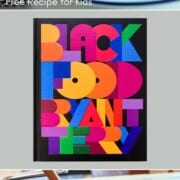
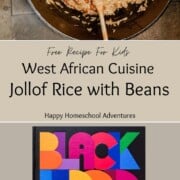
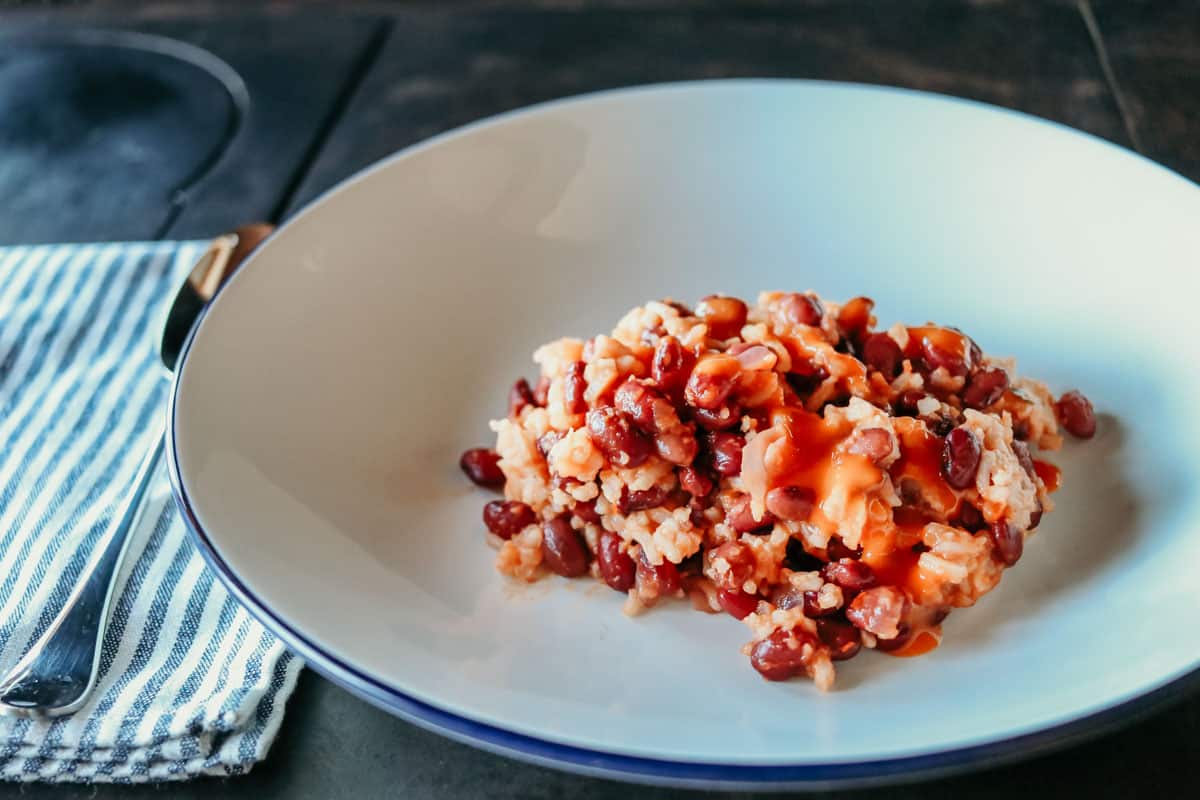
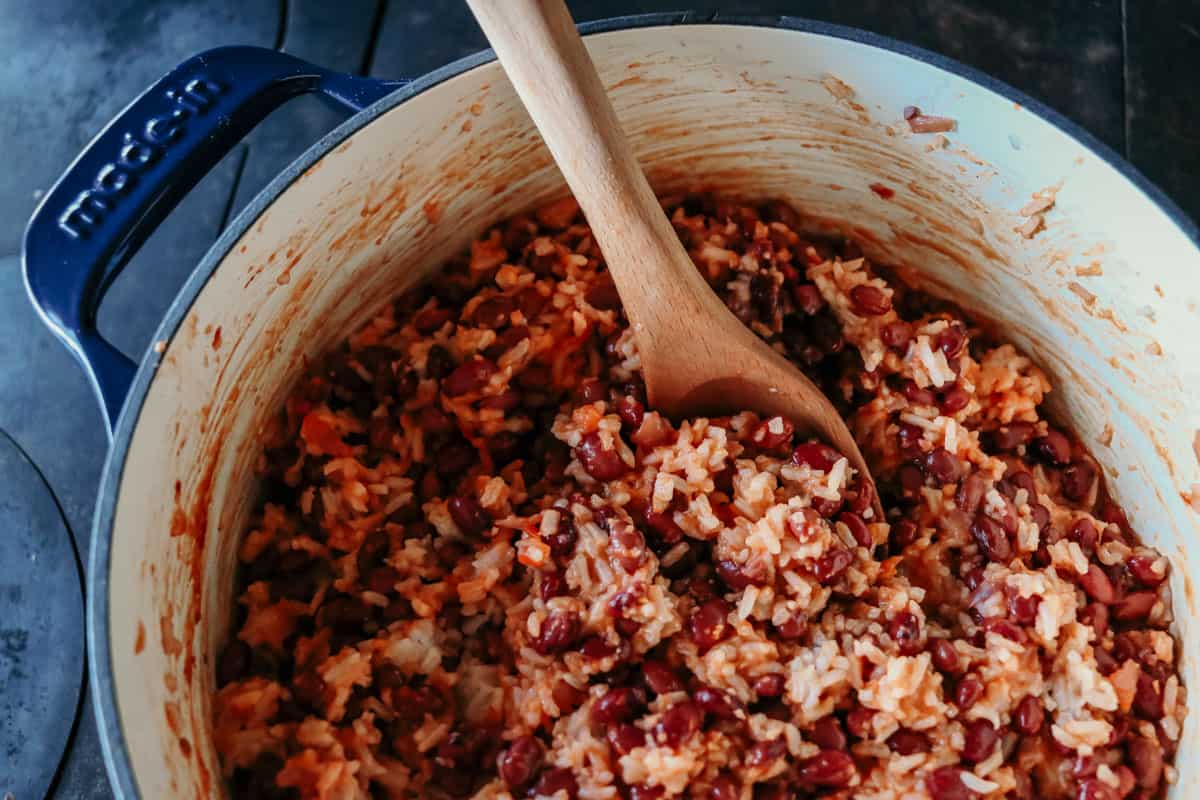
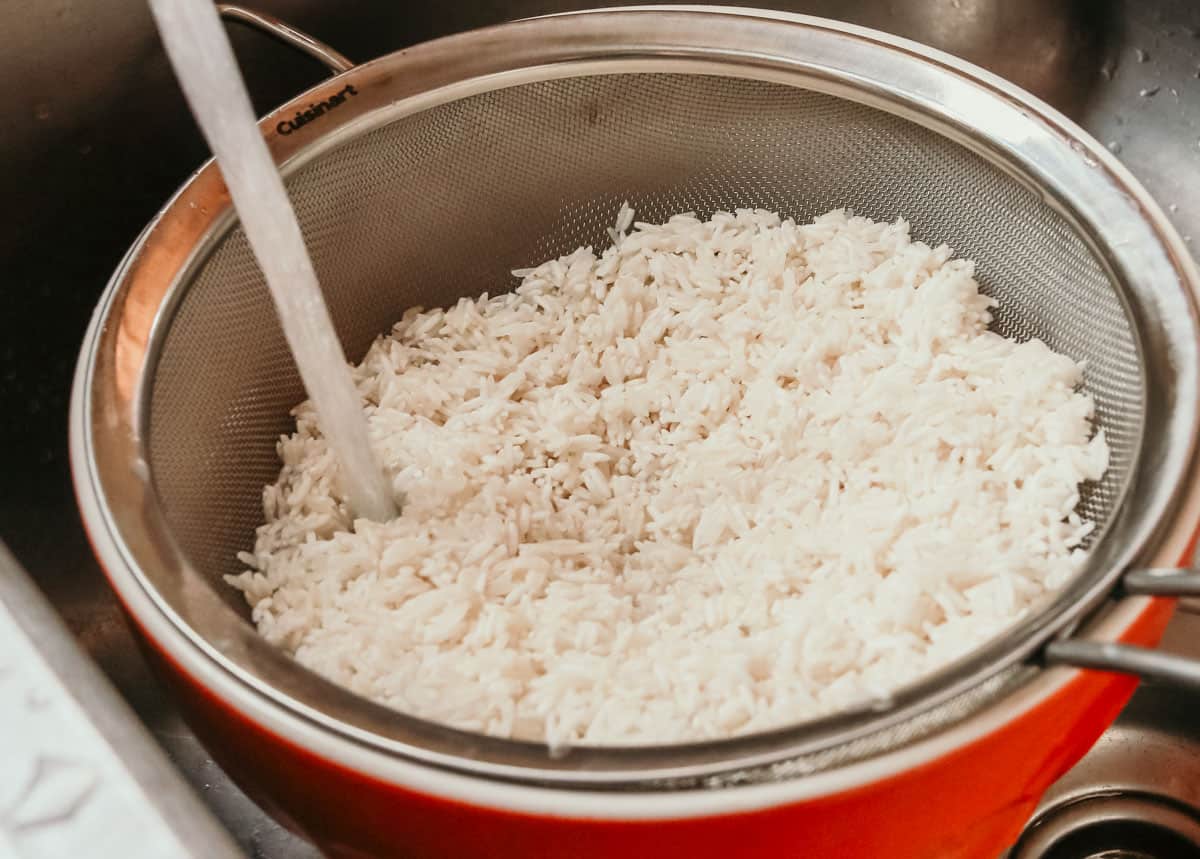
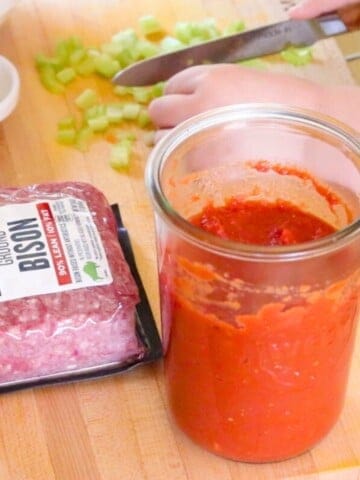
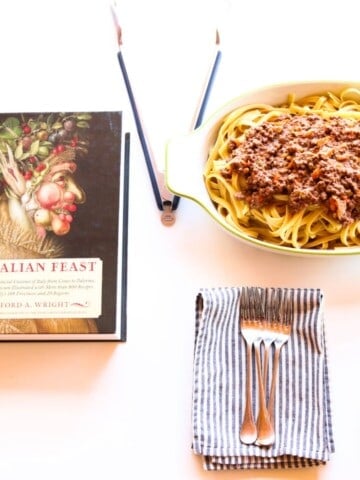


Leave a Reply